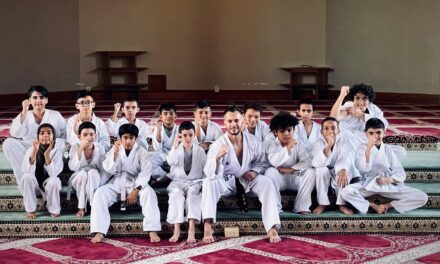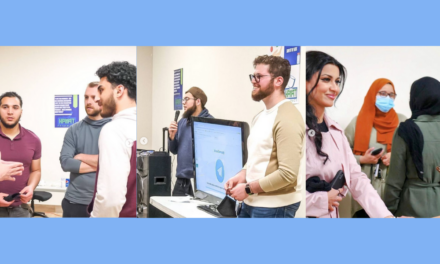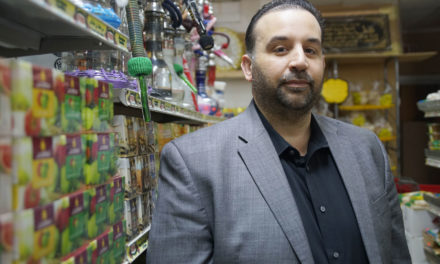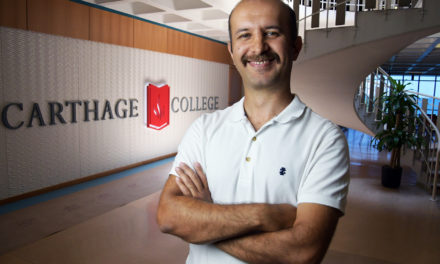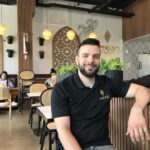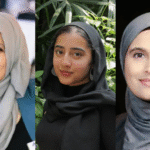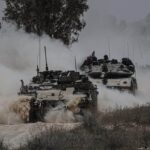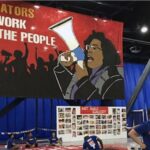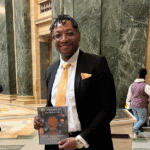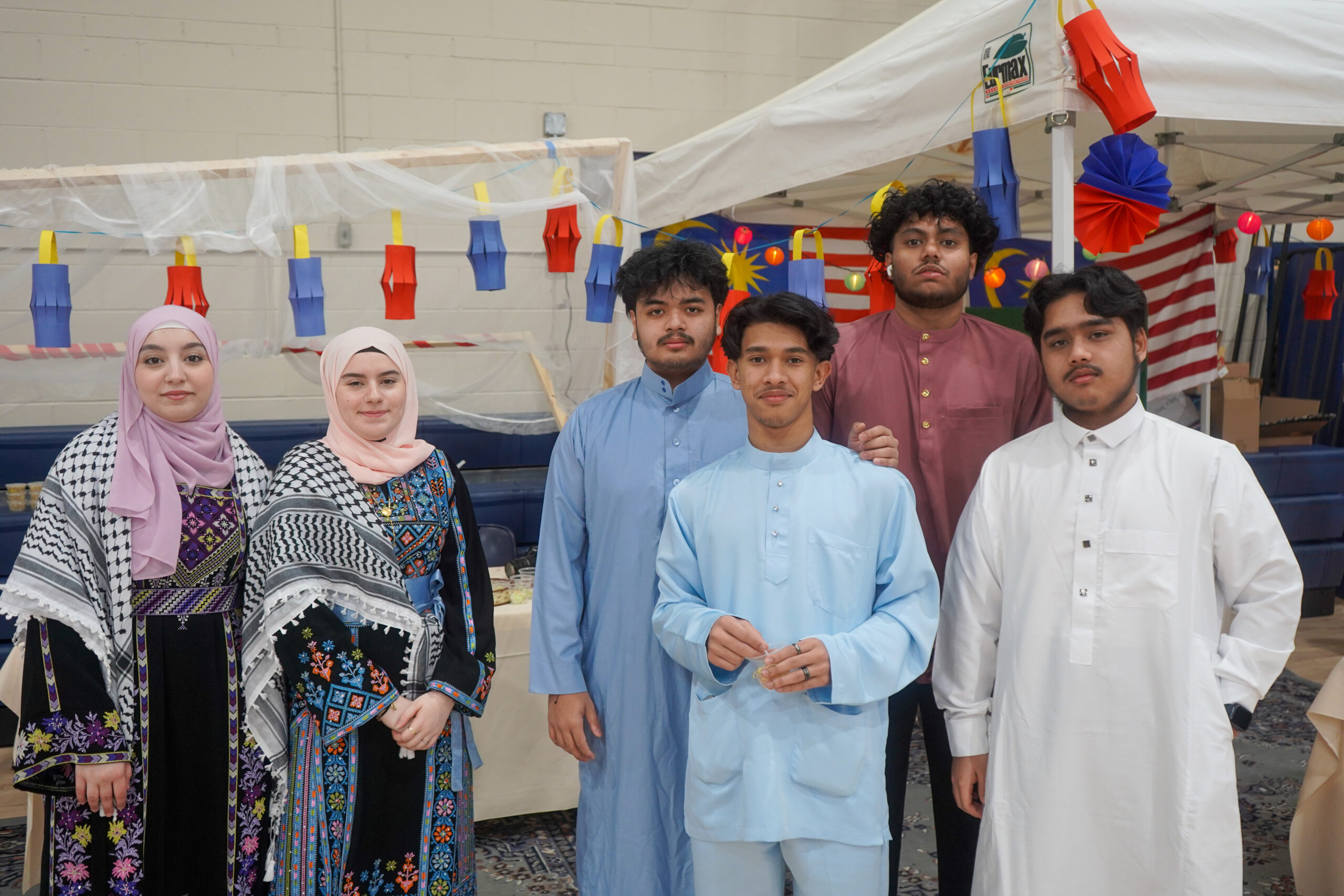
Photos by Kamal Moon
(Left to right) Qamar Abdeljawad, Noor Shanaa, Hidayat Yusuf, Sulaiman AbdulShukur, Yakup Fazal and Idris Mohammad Ayub welcomed guests to the Malaysia exhibit at Salam School’s Multilingual Day festival.
Growing up in Milwaukee’s Muslim community, Salam School senior Bushra Darwish heard Muslim innovators brought many discoveries and concepts to the world—but her school’s annual Multilingual Day project gave her the specifics and showed her the significant impact of Muslims on present-day civilization, she said.
“Every year on Multilingual Day, we focus on something different and include different countries not included in prior years,” Darwish noted. This year’s theme was “the contributions of ancient Islamic universities to present-day knowledge and science.”
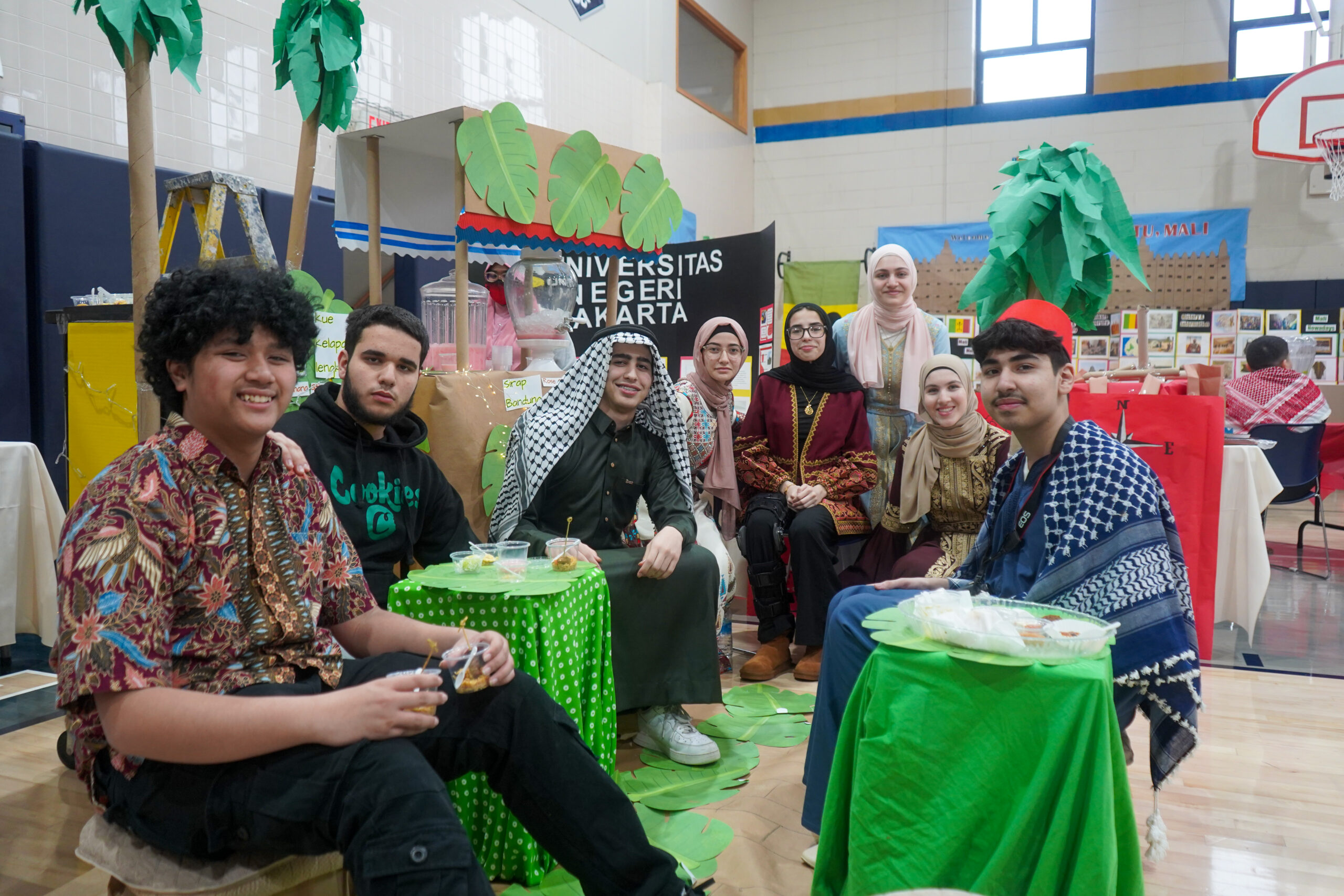
(Left to right) Sophomores Fawwaz Supriyanto, Abdullah Saleh, Aubai Samara, Zeena Saleh, Jana Ismail. Farrah Hedar, Ola Bahhur and Harith Hamdan sit in their recreation of an Indonesian market.
Middle and high school students at Wisconsin’s largest Islamic school spent the past three months researching the incredible scientific advances and development of knowledge made at Islamic universities, including the world’s first university, founded by Muslim women in Morocco. They learned how Muslim scholars launched new disciplines during Europe’s medieval Dark Ages—algebra, trigonometry and chemistry—and made major advances in medicine, astronomy, engineering and agriculture that all contributed to the European Renaissance.
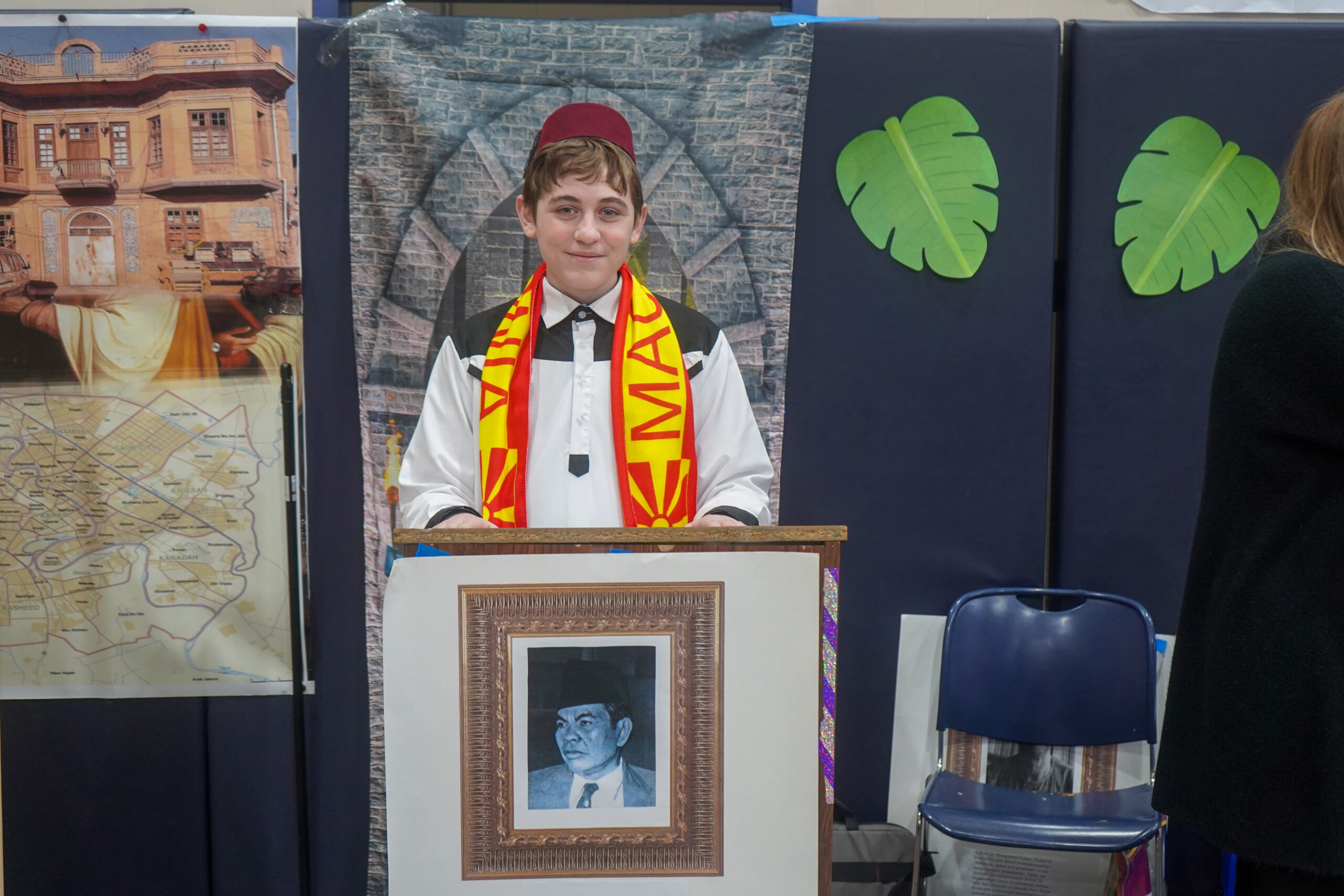
8th grader Ali Tufecki
“Although it does take a lot of time and effort, Multilingual Day is a fun and engaging way for students to learn about different cultures while also teaching others about what they know,” Darwish said.
“Salam School’s MLD receives quite a bit of support, planning and dedication from all stakeholders at Salam School,” Salam School Principal Wanis Shalaby told the Wisconsin Muslim Journal.
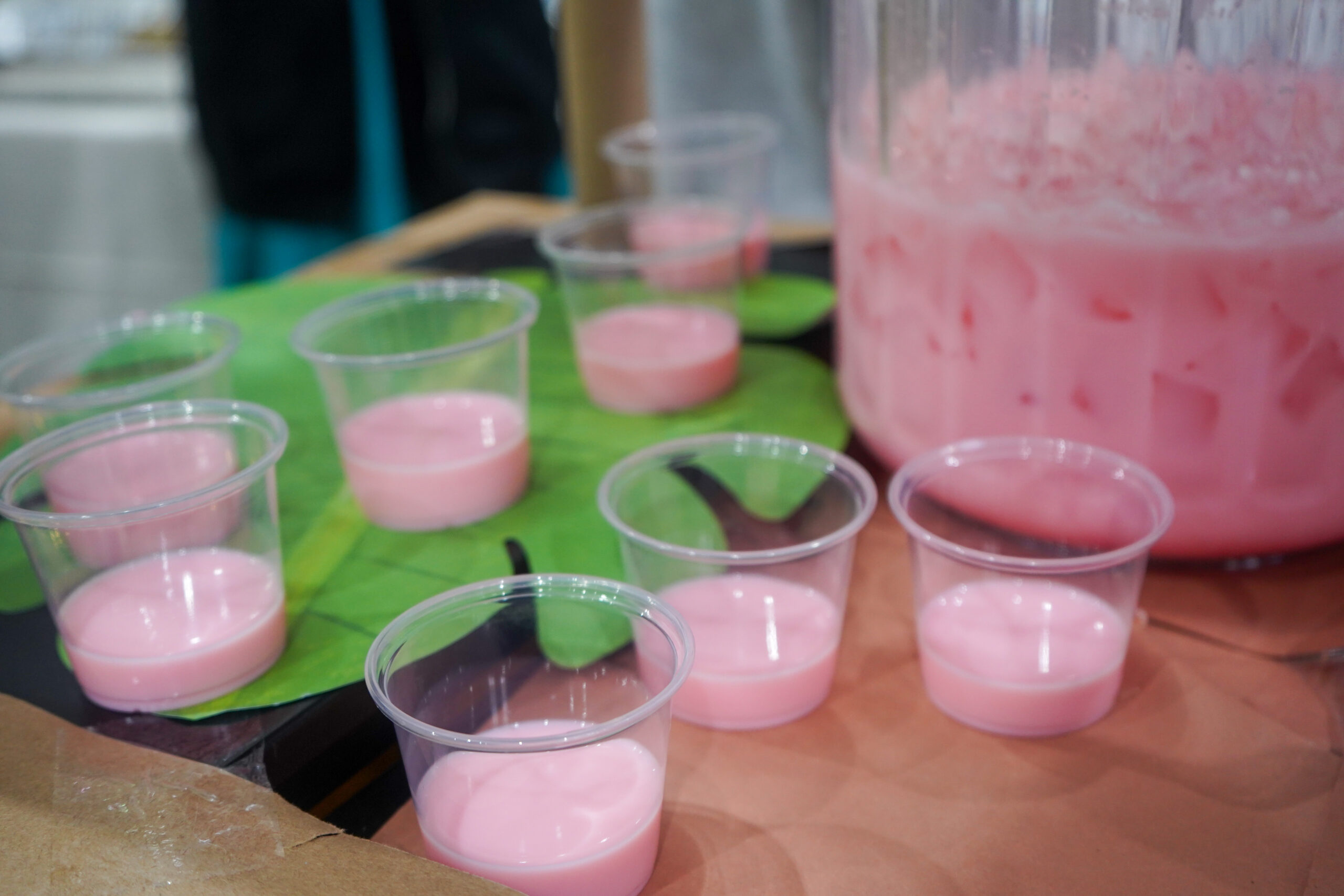
Soda gembira, a popular sweet drink in Indonesia
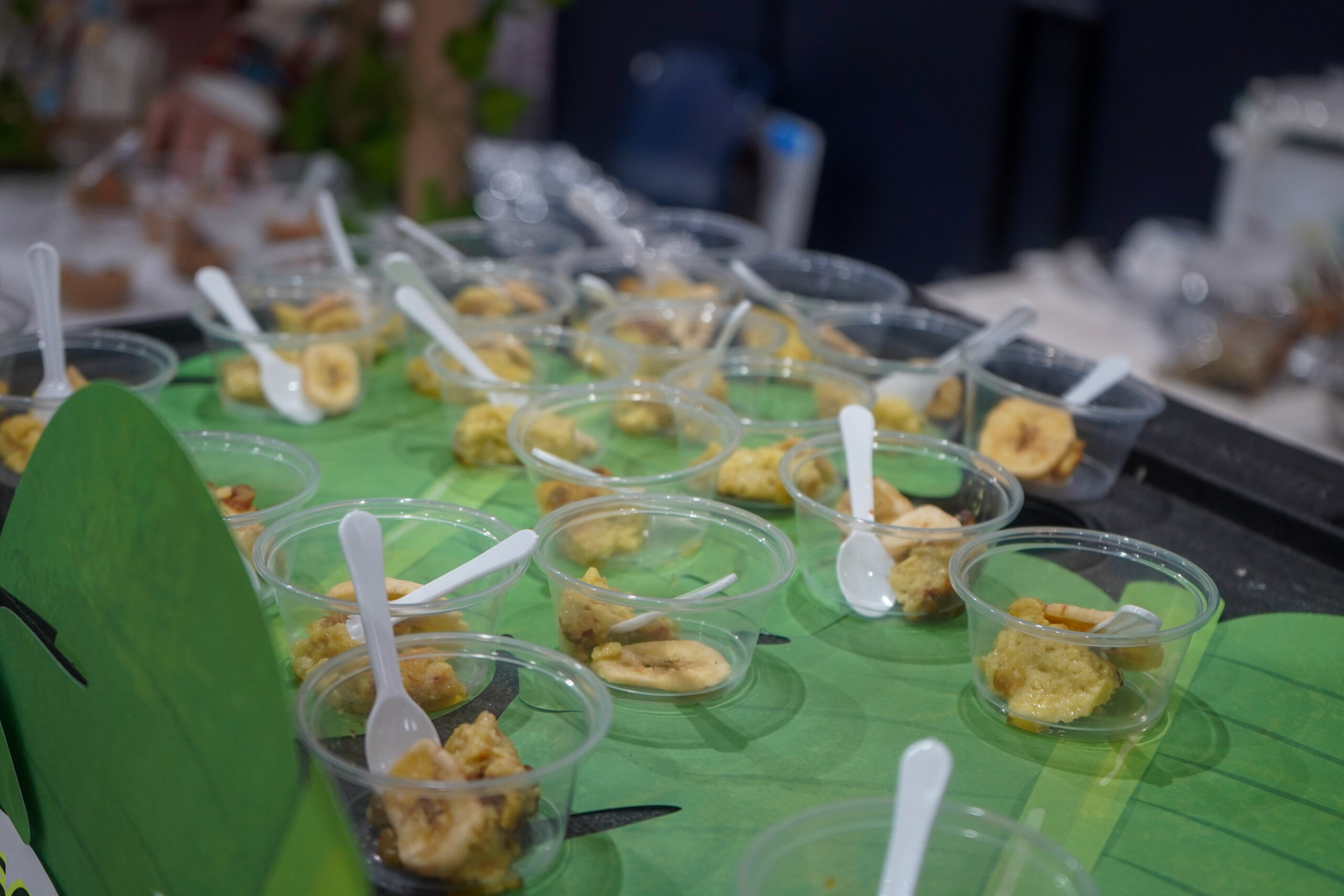
Banana chips, fried banana and nuts were served at the Indonesian booth.
From Arabic Day to Multilingual Day
Salam School’s diverse student body makes the sharing of knowledge especially interesting, noted teachers, students and Principal Shalaby. “Originally Arabic Day, it morphed into Multilingual Day to express the other ethnicities and languages at Salam School,” Shalaby said. Salam School’s 1,100 students come from almost every continent.
Before 2020, Salam School’s Arabic Day celebrated Arab culture and heritage. “At that time, the student body was mostly Arabic speaking,” explained high school mathematics teacher Arnab Mahanta, who has taught at Salam School for eight years. “The demography has changed and we are now a true ethnic diversity of Muslim young people coming from all over the world, from North Africa, Myanmar, India, Pakistan, Bangladesh, Indonesia, Somalia, Tunisia—we even have a few Bosnian and Albanian students. Kids take so much pride in displaying their ethnicity, their culture, their food. I think for the Muslim community in Milwaukee, it brings a real cohesiveness into the school and the community.
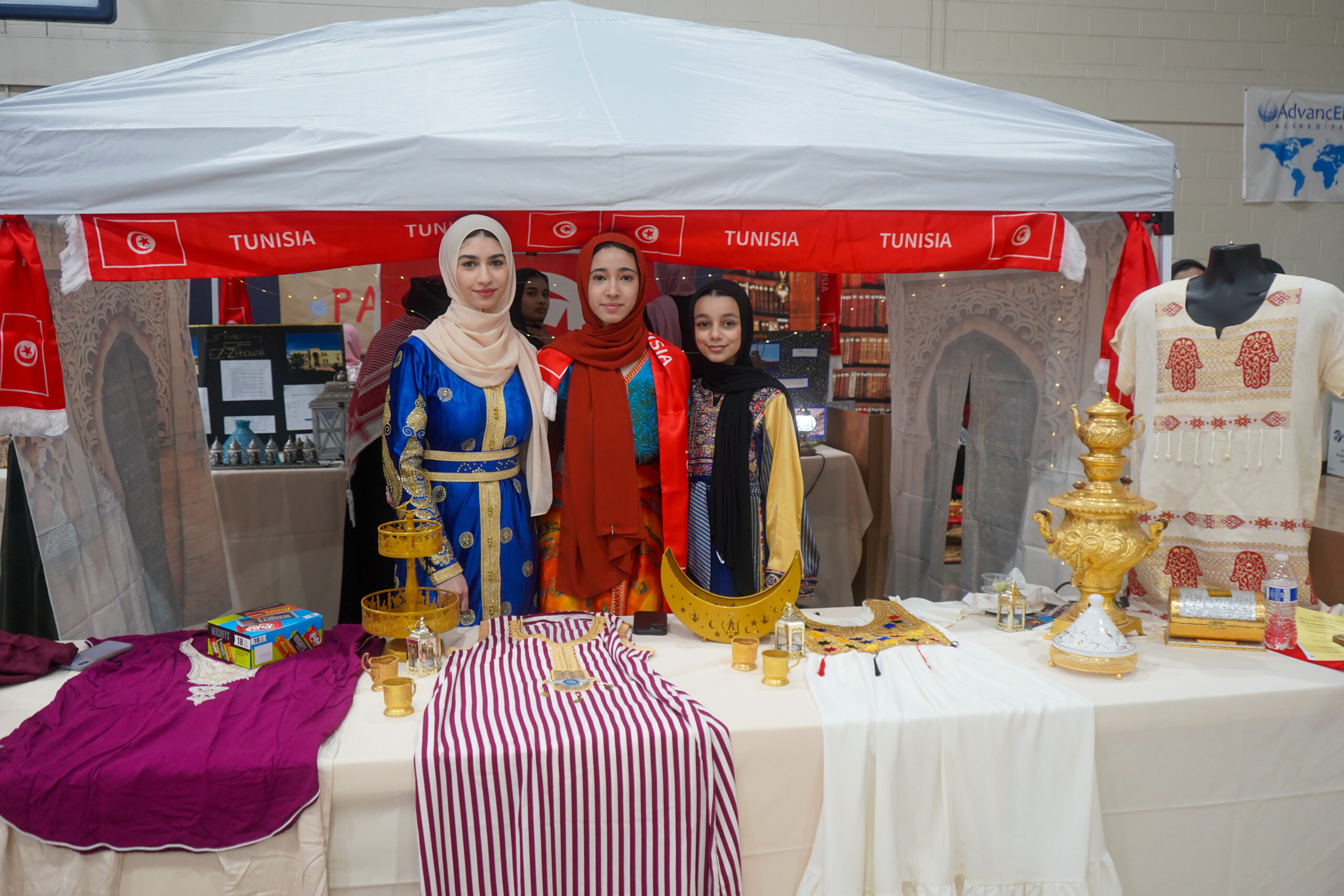
(Left to right) Yassmine and Narjis Hachani and Amani Hamed show guests Tunisian art and clothing.
“It is a big investment of time and energy but it is so absolutely worth it,” Mahanta continued. “The innovations of scholars in places like Tunisia, the Iberian Peninsula, Morocco, India and other predominantly Muslim countries are not portrayed well in our regular Western history books. It inspires a sense of pride in our students about where, if not them, their parents and grandparents came from.”
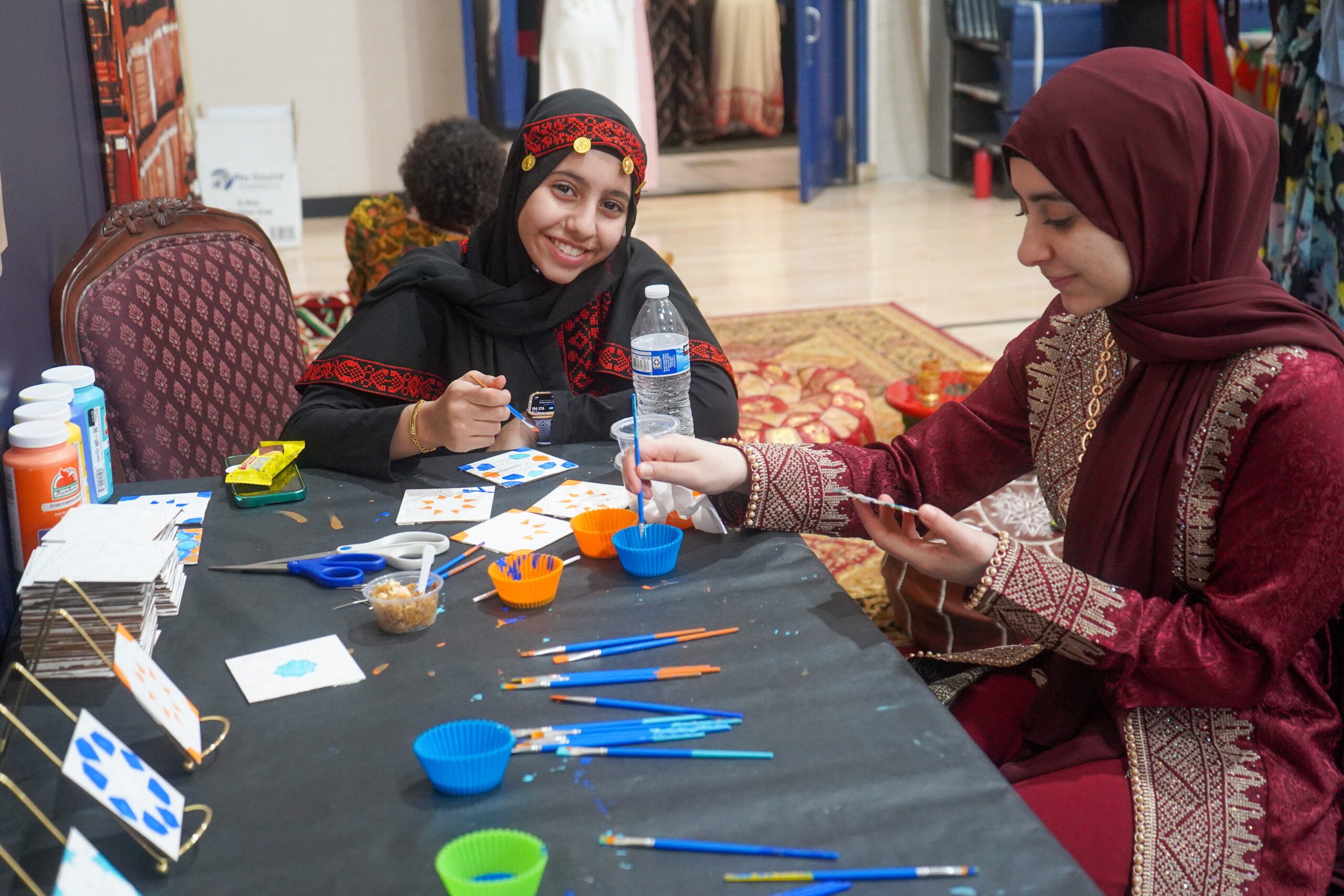
Ninth graders Danya Shibayih and Marwa Bazzar paint Islamic tiles at the Tunisian exhibit.
When science teacher Sahar Ahmad started at Salam School 14 years ago, the Arab community was the majority. Now they are becoming the minority, observed Ahmad, a member of the MLD planning committee. “That’s reflective of what’s happening in the world today. As people become displaced, we find Milwaukee is a very welcoming community. Our Muslim community especially is always opening its doors.
“We hope that our Multilingual Day reflects the diversity of our students,” she continued. “Every year we change countries and learn about different cultures, and about how Islam is practiced in different countries. They seem to be very happy with it.”
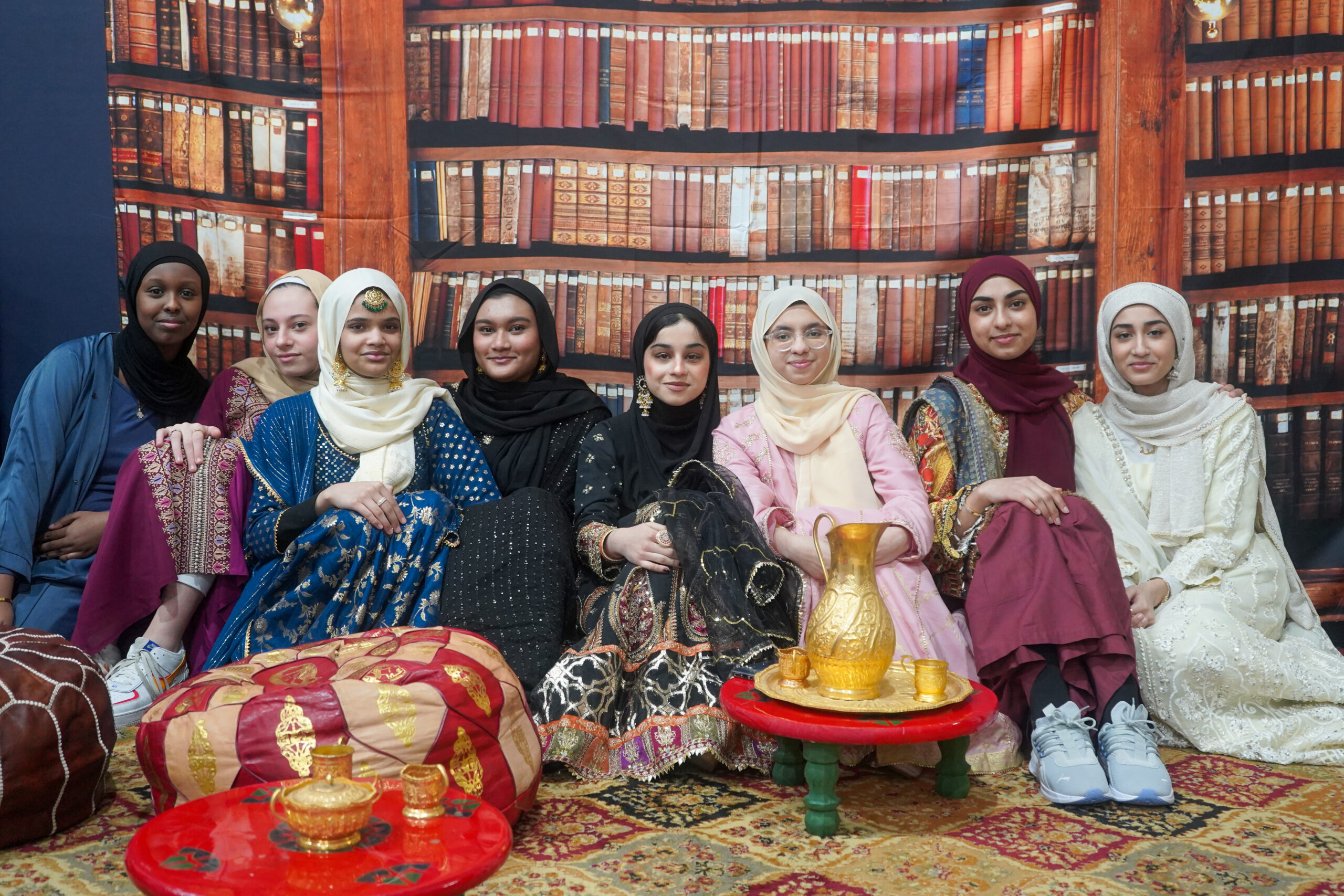
(Left to right) Juniors Anisa Raghe, Dena Shelleh, Maryam Bajabar, Muminah Mohamed Karim, Amina Fathima, Duaa Rehman, Bismah Qhavi and Aamina Farooq gathered in the Tunisian Tea Room.
The nuts and bolts
The planning committee sent out an announcement before the winter break with a list of countries available and asked all middle and high school students to think about their choice for the project. Later students received a link to a Google sign-up sheet to sign up.
Middle and high school students at Wisconsin’s largest Islamic School then spent three months working in eight or nine multi-grade teams to research the theme of the year for their specific country, creating exhibit booths and performances to show what they discovered.
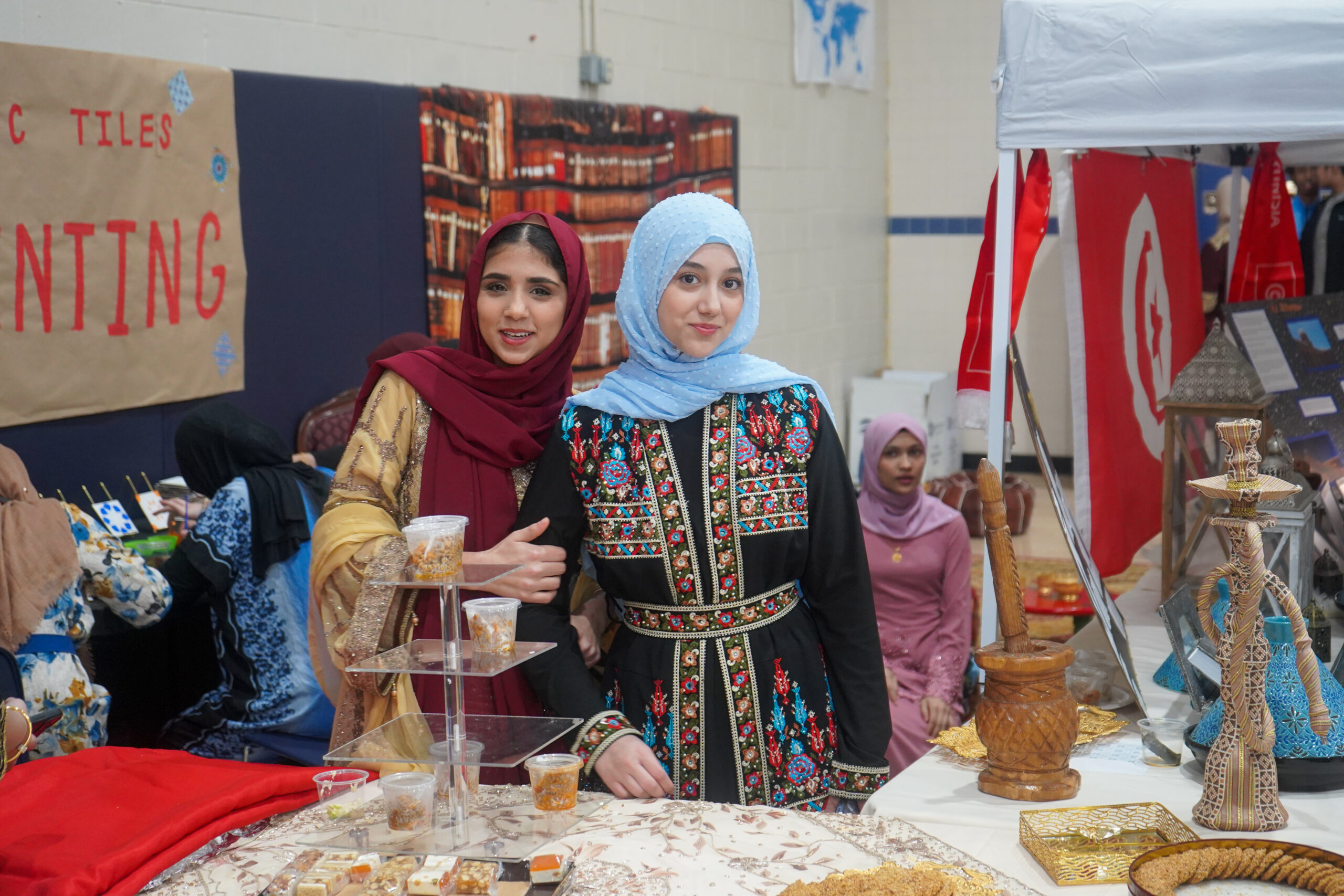
(Left to right) Sophomores Khkola Halimay and Maryam Ali wear decorative galabeas, long cotton dresses or tunics often worn in the Middle East and North Africa.
The multi-grade aspect is important, Ahmad said. “Seventh graders work in the same room with 11th and 12th graders. Just that modeling of that behavior, that confidence about what to do and what to expect makes it easier for the younger students to ease into it. It is a big project for them.”
She appreciates the “ways the school bends over backward to give us time to work together,” she said. “We do three shortened schedules where we are not compromising the academics, but we are, at the same time, saying to students, ‘Your background, your culture is important to us.’”

(Left to right) Yeheya Mohammad and Mohammad Odeh welcome guests to the Iraq exhibit.
The big day
Salam School’s gym transformed Thursday into a grand exhibit hall with booths displaying information about Islamic universities and other features of Malaysia, Indonesia, Egypt, Morocco, Tunisia, India and Pakistan, the Iberian Peninsula, Iraq and Timbuktu. Students constructed impressive models, including one of Egypt’s pyramids, Indonesia food carts and a three-dimensional relief map of the Nile. An art project featured Tunisia’s Islamic tiles. Every booth served tasty samples of food.
Students dressed in traditional clothing from the countries they studied. Some had similar clothing at home, others borrowed clothing from classmates or community members from different backgrounds. Even Salam School Girls Basketball coach and co-athletic director Kass Macak wore a Palestinian galabea, black with intricate red embroidery, provided by one of her players.
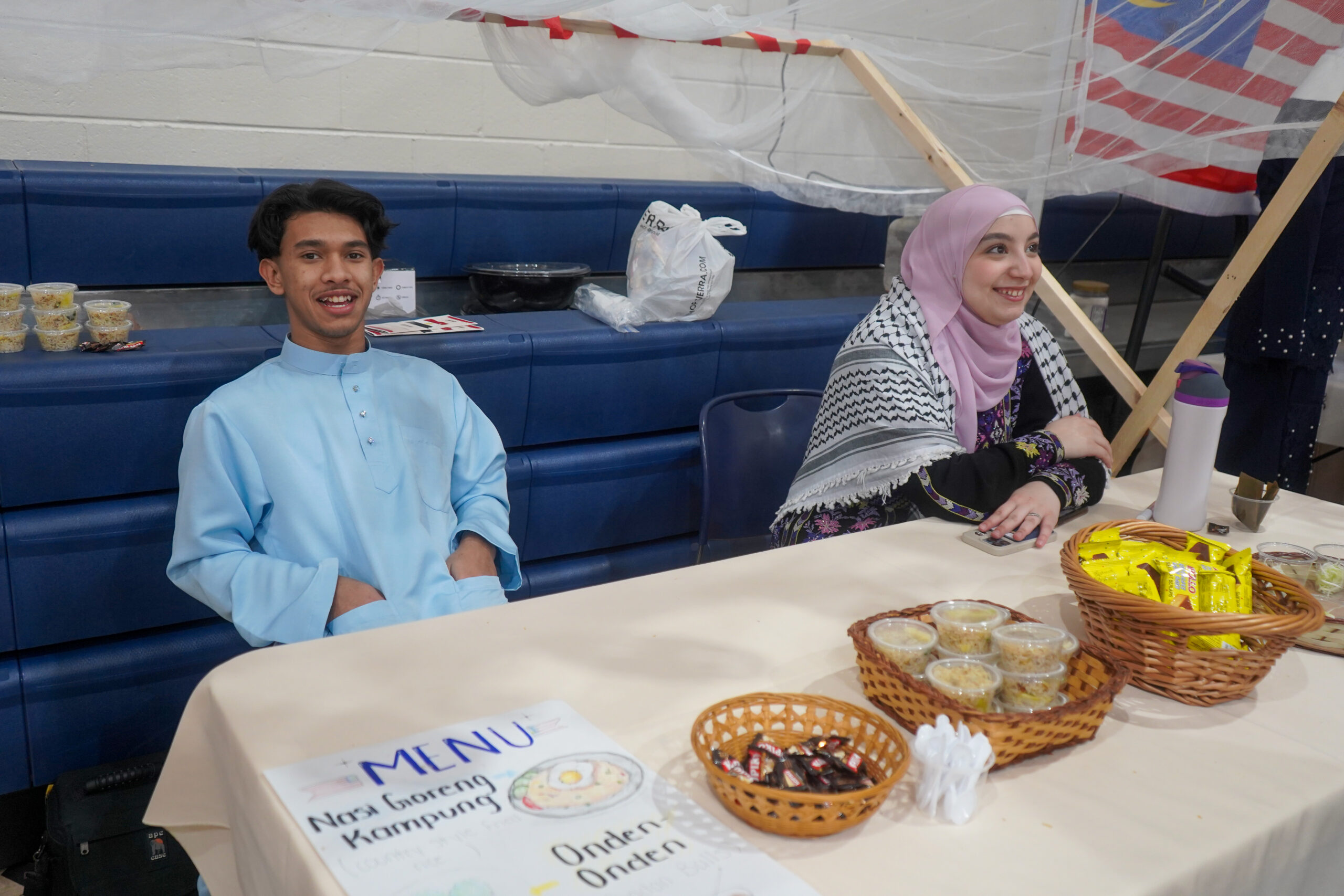
(Left to right) Sulaiman AbdulShukur and Qamar Abdeljawad at the Malyasian exhibit.
Islamic Society of Milwaukee director Othman Atta toured the booths, reading posters about universities, scholars and inventions, and, of course, trying the food. “I come every year to enjoy the booths and the food,” he said.
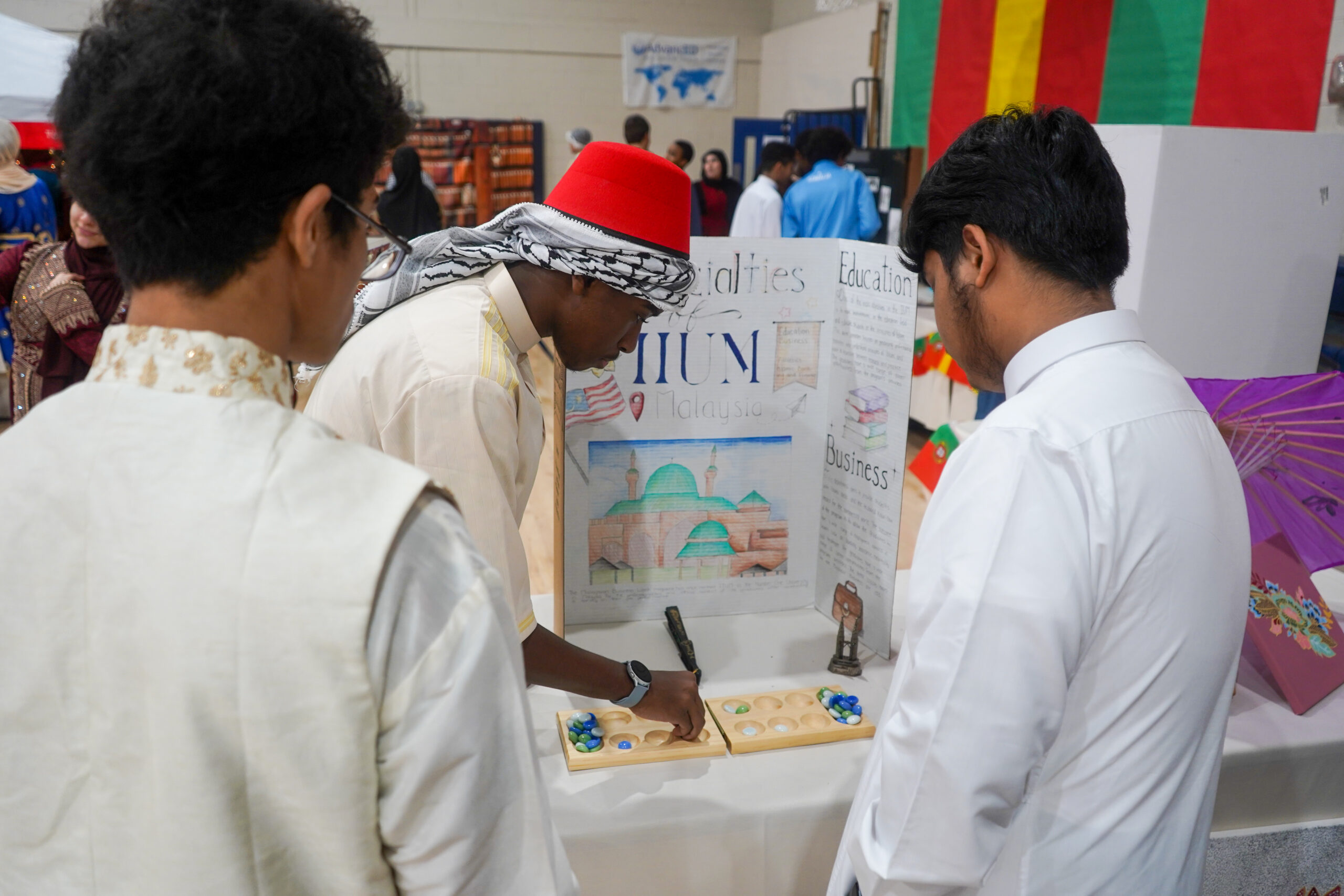
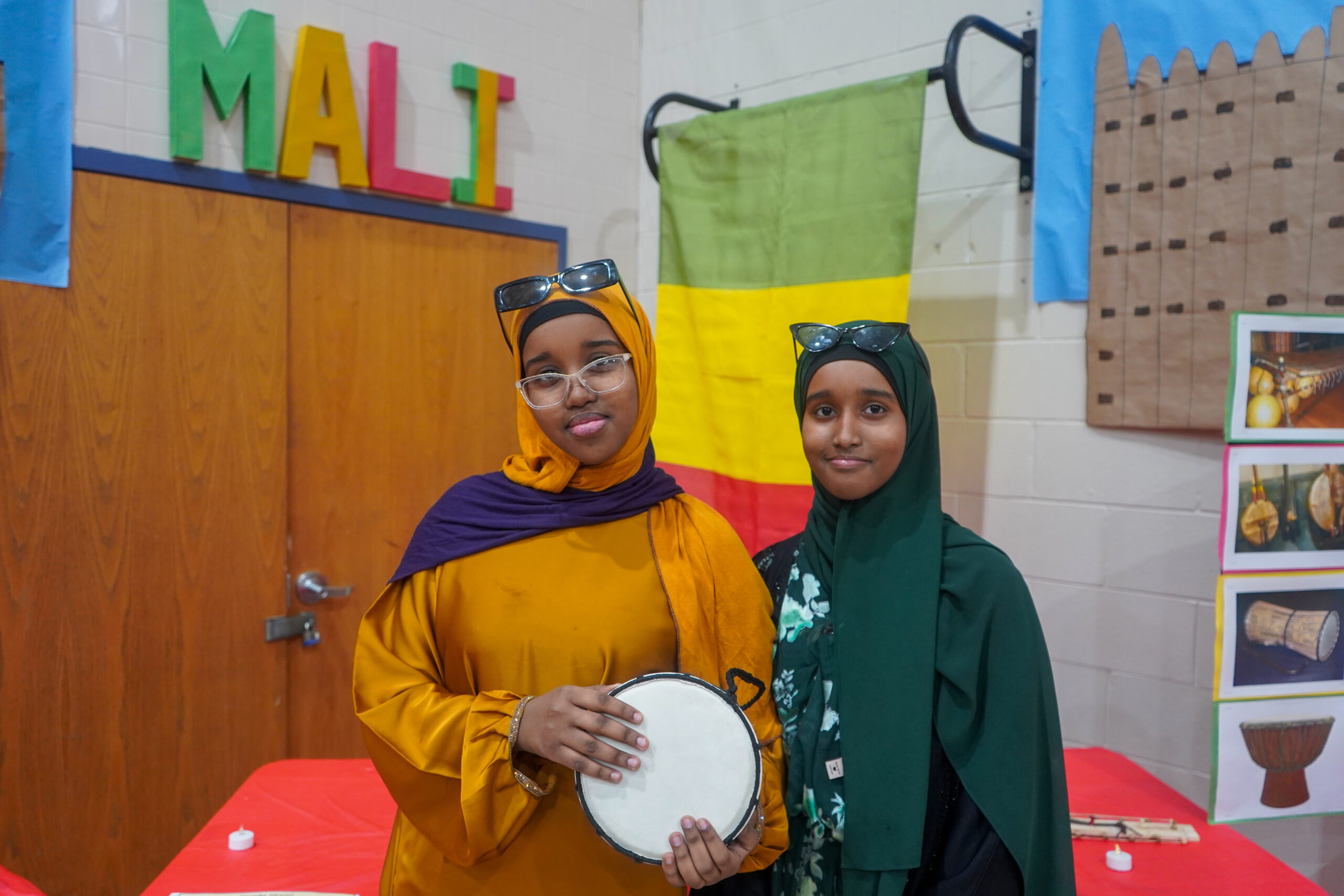
(Left to right) Hodo Ali and Aisha Mohamed
Salam School Photography Club member Miski Abdi, a 10th grader, also made the rounds, snapping shots of people and displays for the school newspaper. “I took over 100 pictures,” she exclaimed. “We’ve been planning the MLD program for a while now so everybody gets really excited.”
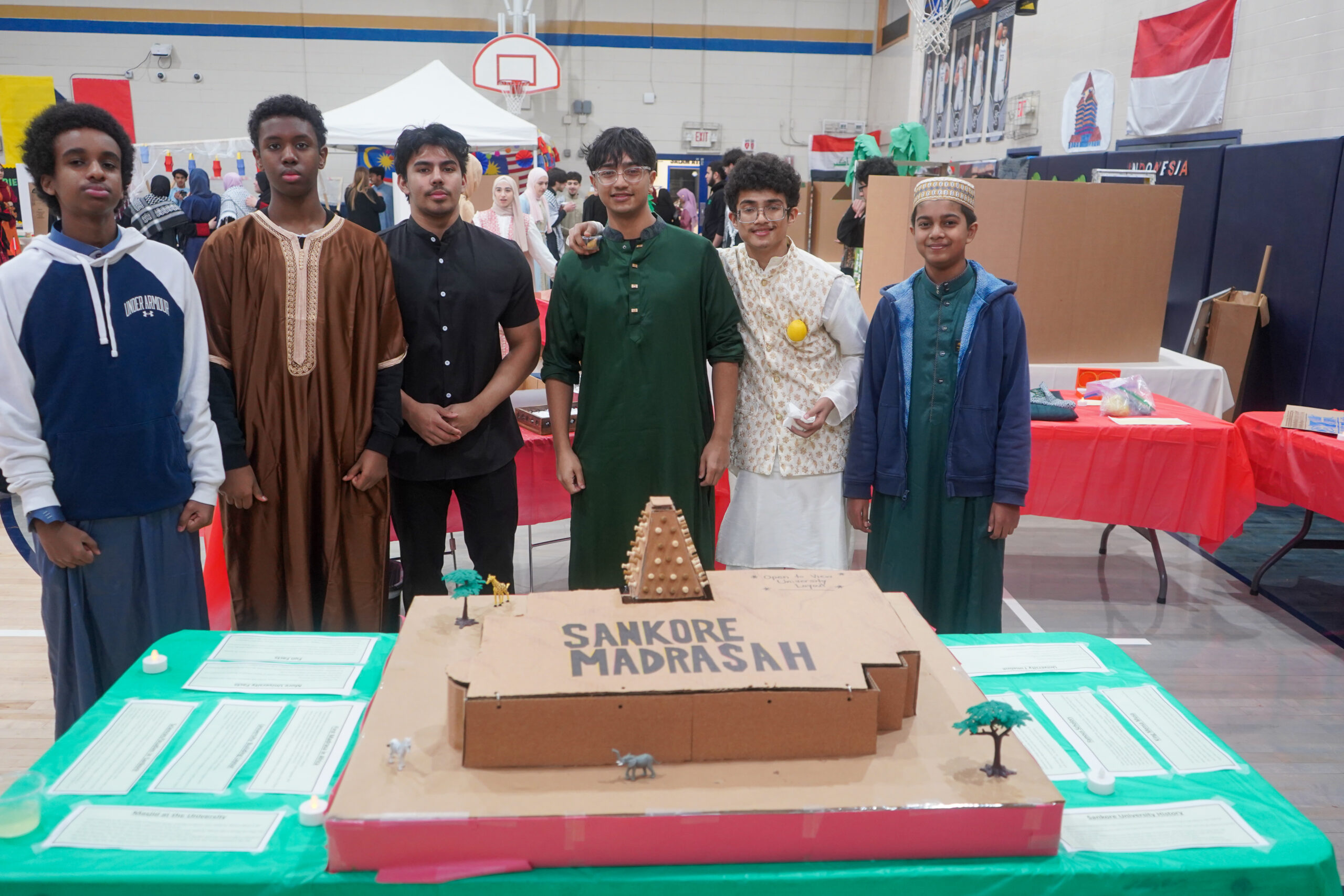
(Left to right) Zubair Sharif, 10th grade; Yacqub Rage, 9th grade; Imran Ali, 11th grade; Anas Abrar, 10th grade; Adnan Hamidullah, 10th grade; and Abdu Rahzak Rahimullah, 7th grade
At the Iraq booth, senior Yeheya Mohammad explained that much of our current knowledge about light developed from the work of Ibn al-Haytham, who was born in present-day Iraq a thousand years ago. (He is known in the West by the Latinized form of his first name, “Alhazen.”) His work helped us understand vision, optics and light, Mohammad said. “He is basically the founding father of our knowledge of how light works.”
Mohammad’s team worked on a pinhole camera, and brought in tools like convex and concave mirrors that show how refraction and reflection work.
“This is all new knowledge for me, thanks to MLD,” Mohammad added. “It’s hard work, but the outcome is very nice. You get a lot of new information. It brings a lot of necessary knowledge.”
As a student who is “very interested in virtual reality, which is related to light,” he found Ibn al-Haytham’s work, well, enlightening. He thinks it will be beneficial as he prepares to pursue higher education at the University of Wisconsin-Madison in computer science.
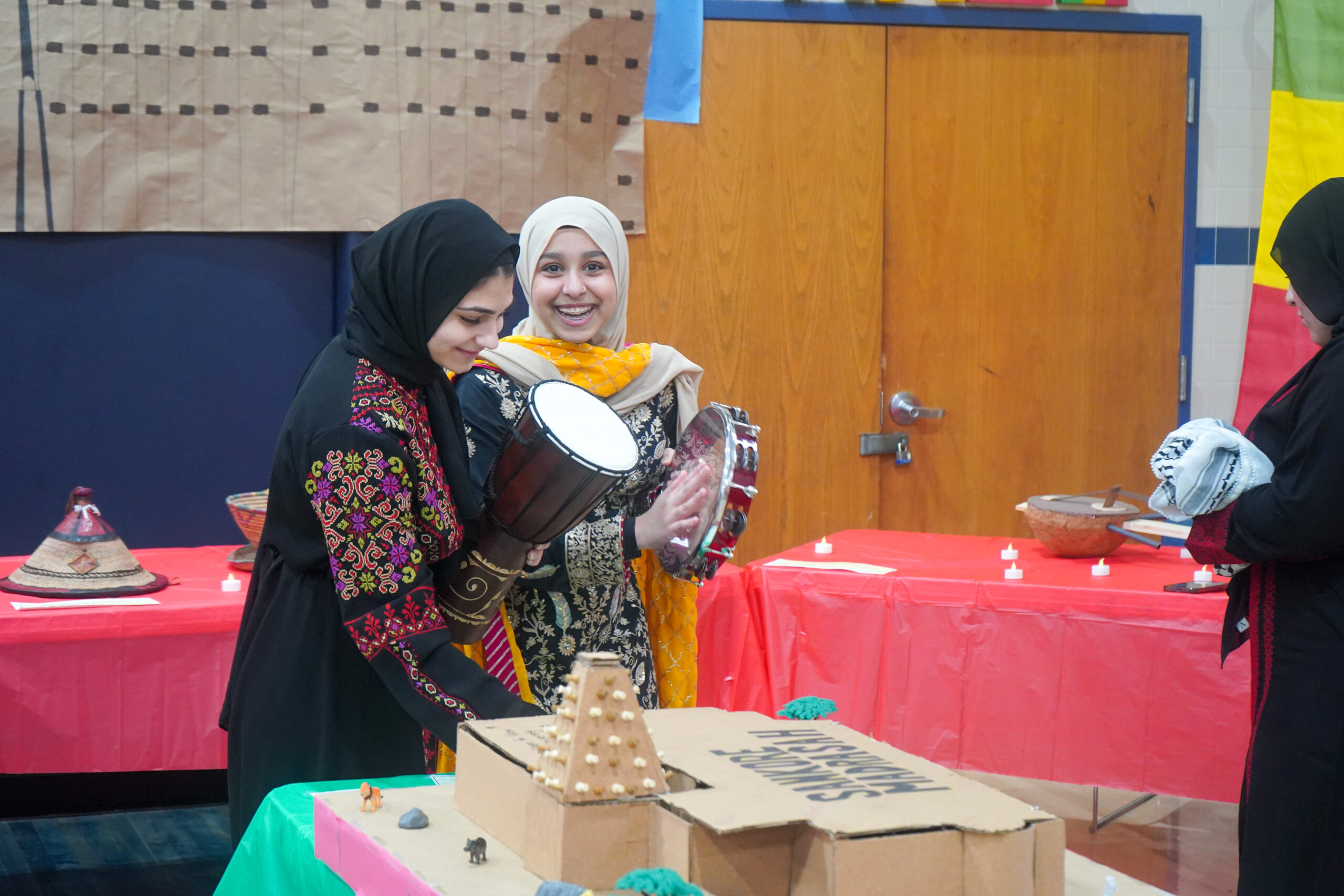
Sophomores Ayat Abdallah and Fatima Hameed experienced musical instruments of Africa.
Eleventh graders Noor Shanaa and Qamar Abdeljawad helped in the Malaysian group. “We made sure there was plenty of food and everyone gets something,” Shanaa said. Shanaa and Abdeljawad are of Palestinian heritage but they asked Malaysian people to help them, they said.
Malaysian artwork impressed Shanaa, who is also a budding artist. She found it “colorful and bright, really vibrant,” with “lots of flowers.”
Abdeljawad appreciated Malaysians’ diversity in clothing, she said. “In each area of Malaysia, they wear different styles. Their clothing is very detailed with a lot of lace and beading. It is really nice.”
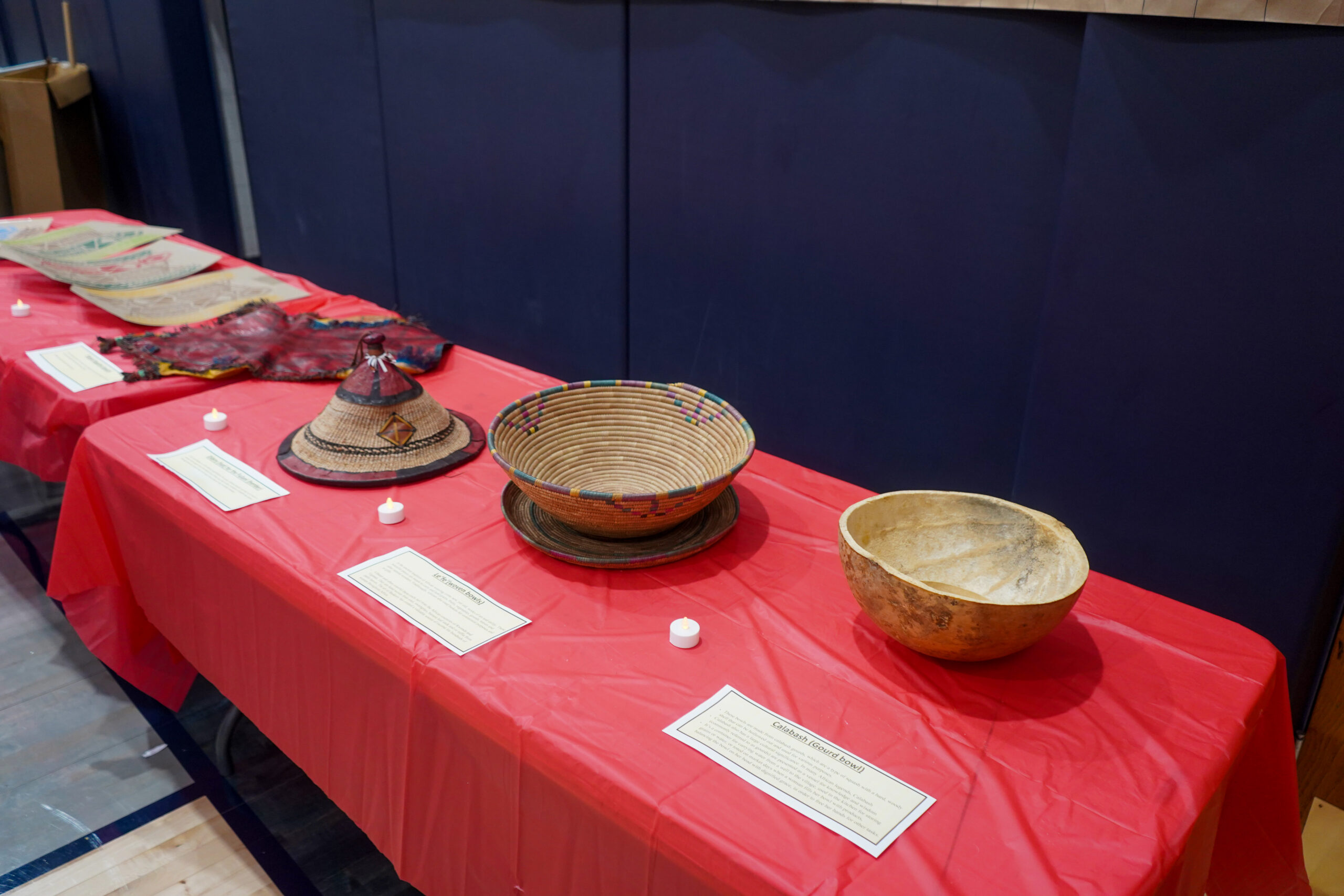
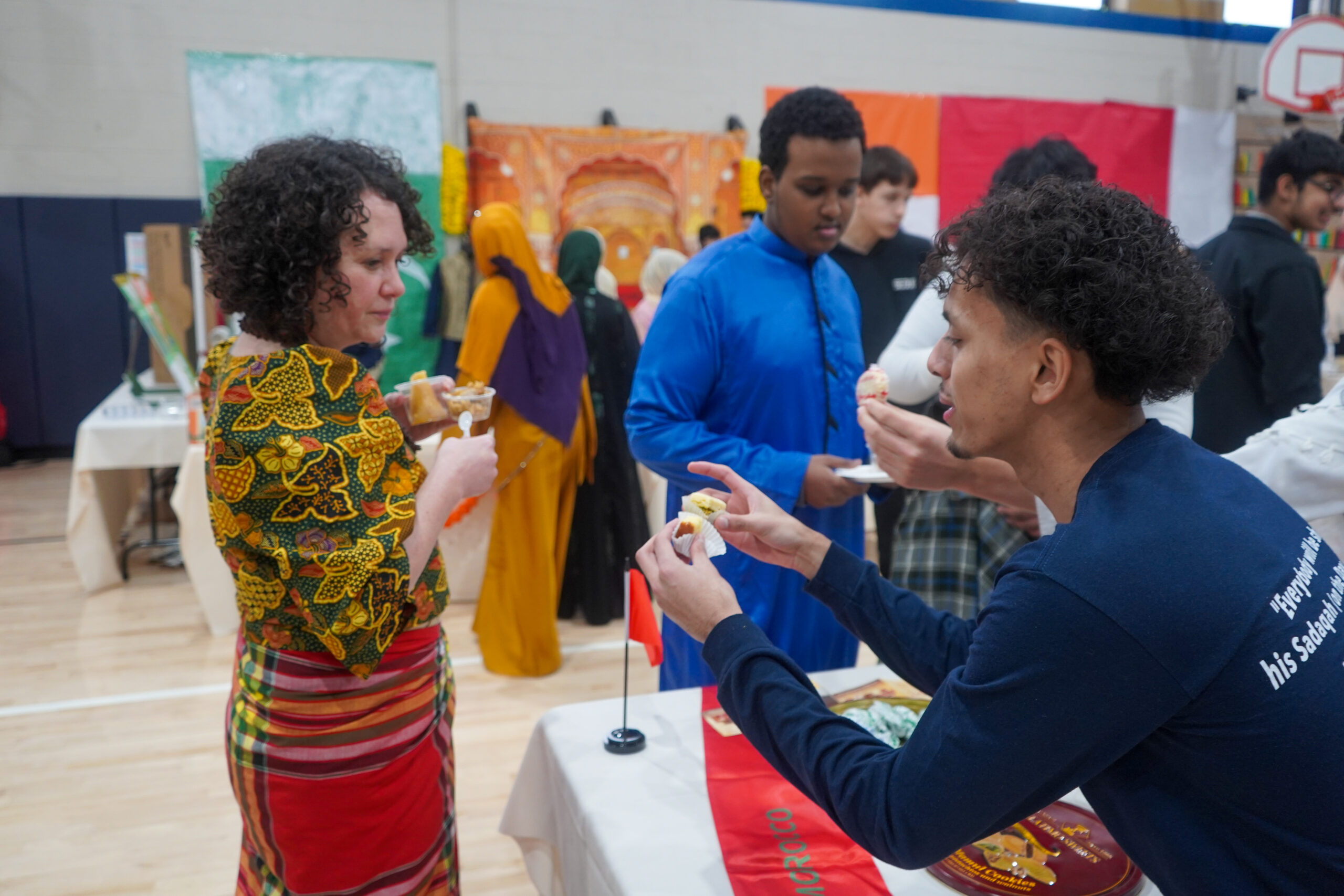
English teacher Anna Stone samples a Moroccan sweet.
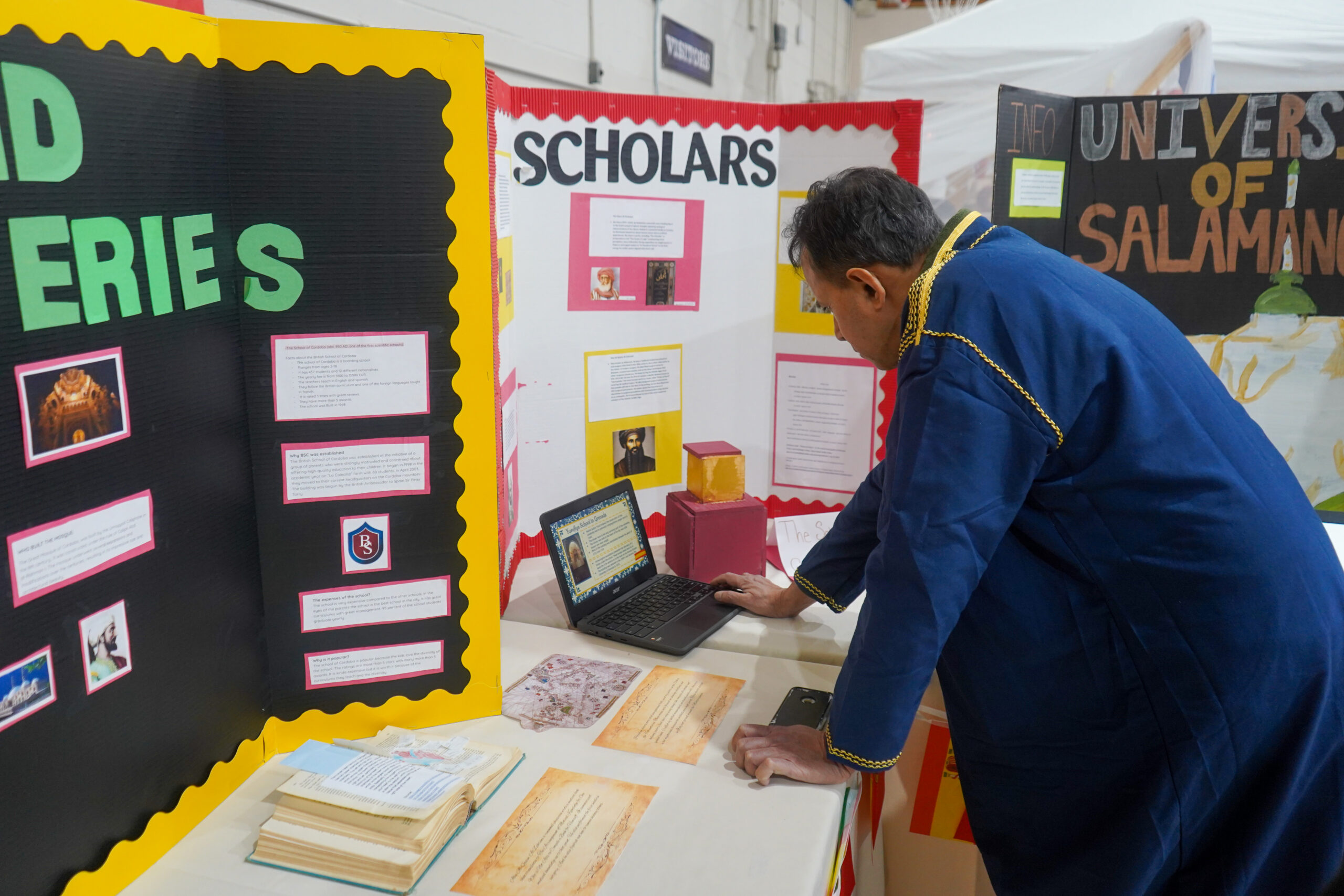
Mathematics teacher Arnab Mahanta
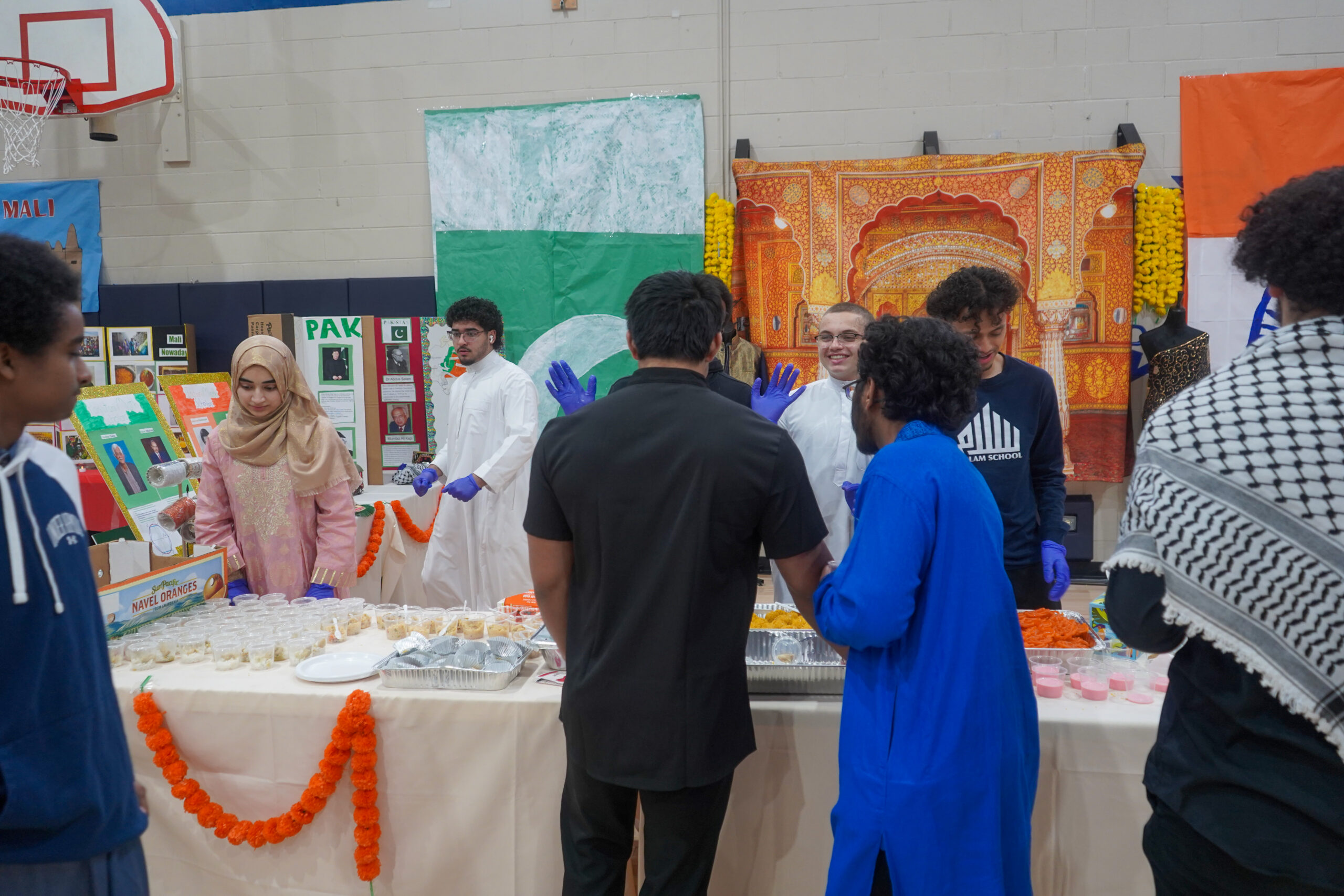
Students serve foods of India and Pakistan.
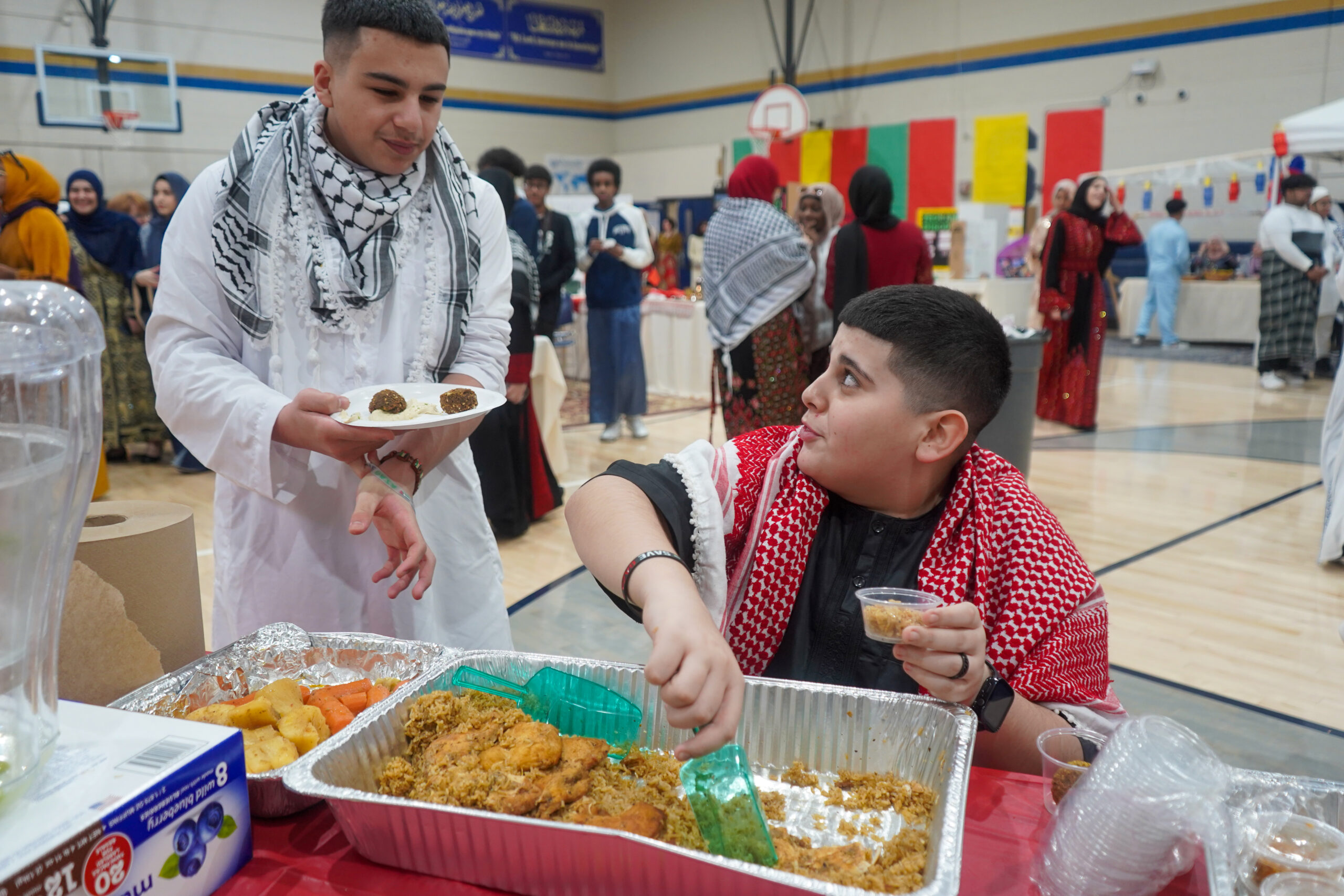
Freshman Saif Farhan (left) visits the Mali booth as 8th grader Anas Tubeishat (right) shares a sample of food.
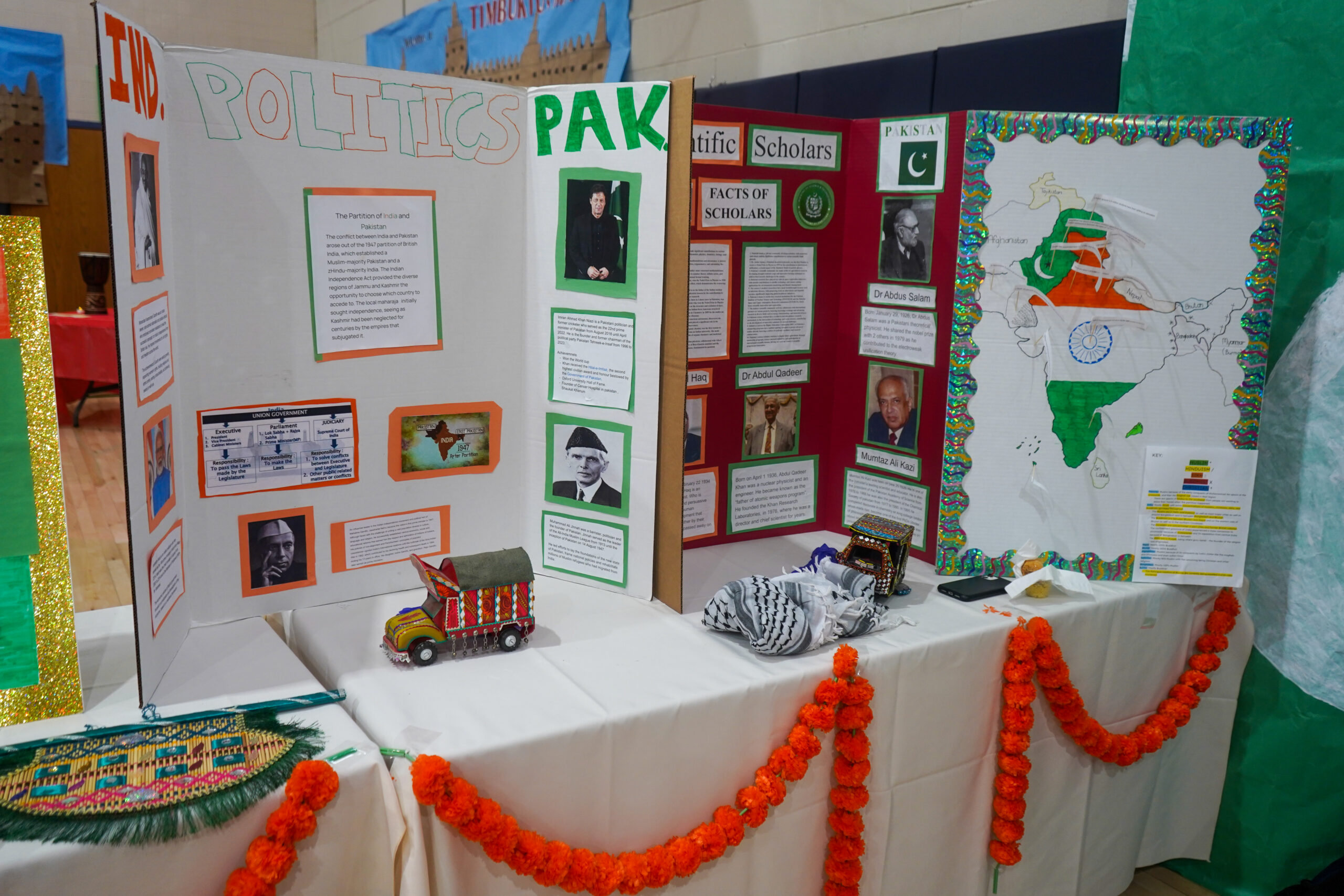
India/Pakistan exhibit
Sophomore Hya Abdeljawad shared information at the Iberian Peninsula booth. Posters about technological developments, geography, Islamic universities and scholars were featured in the display. “The culture is so rich and very similar to Arab/Muslim culture,” she said. “Parts of their languages (Spanish and Portuguese) are like Arabic.”
Sophomore Leen Shahin and junior Razan Murad built food carts in the Indonesian display. “We brought in carts and covered them in cardboard to make them look like food carts,” Shahin explained. “We made roofs and everything. It took about three days. It takes a lot of time but on the day of, it’s really fun to see everyone’s projects.”
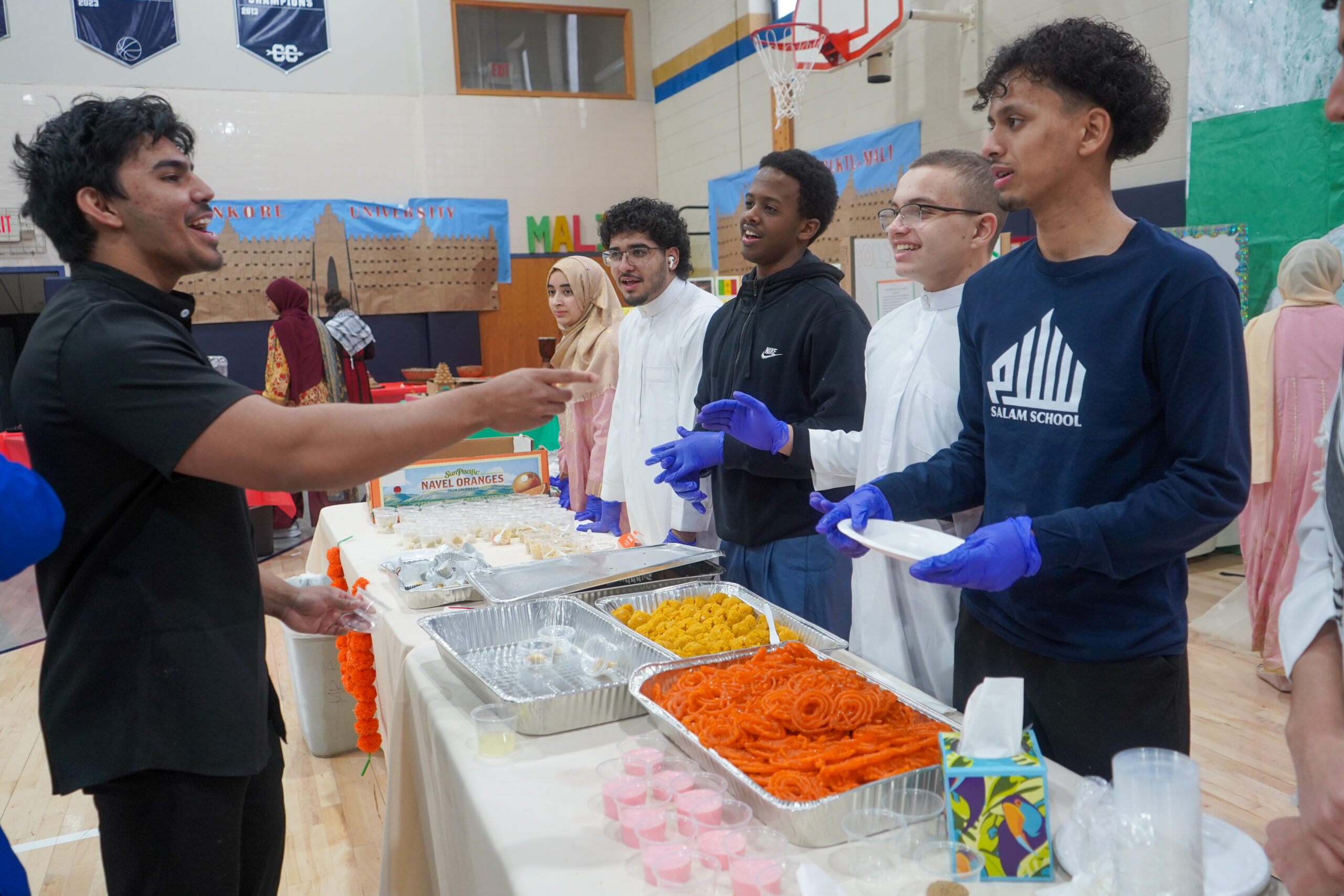
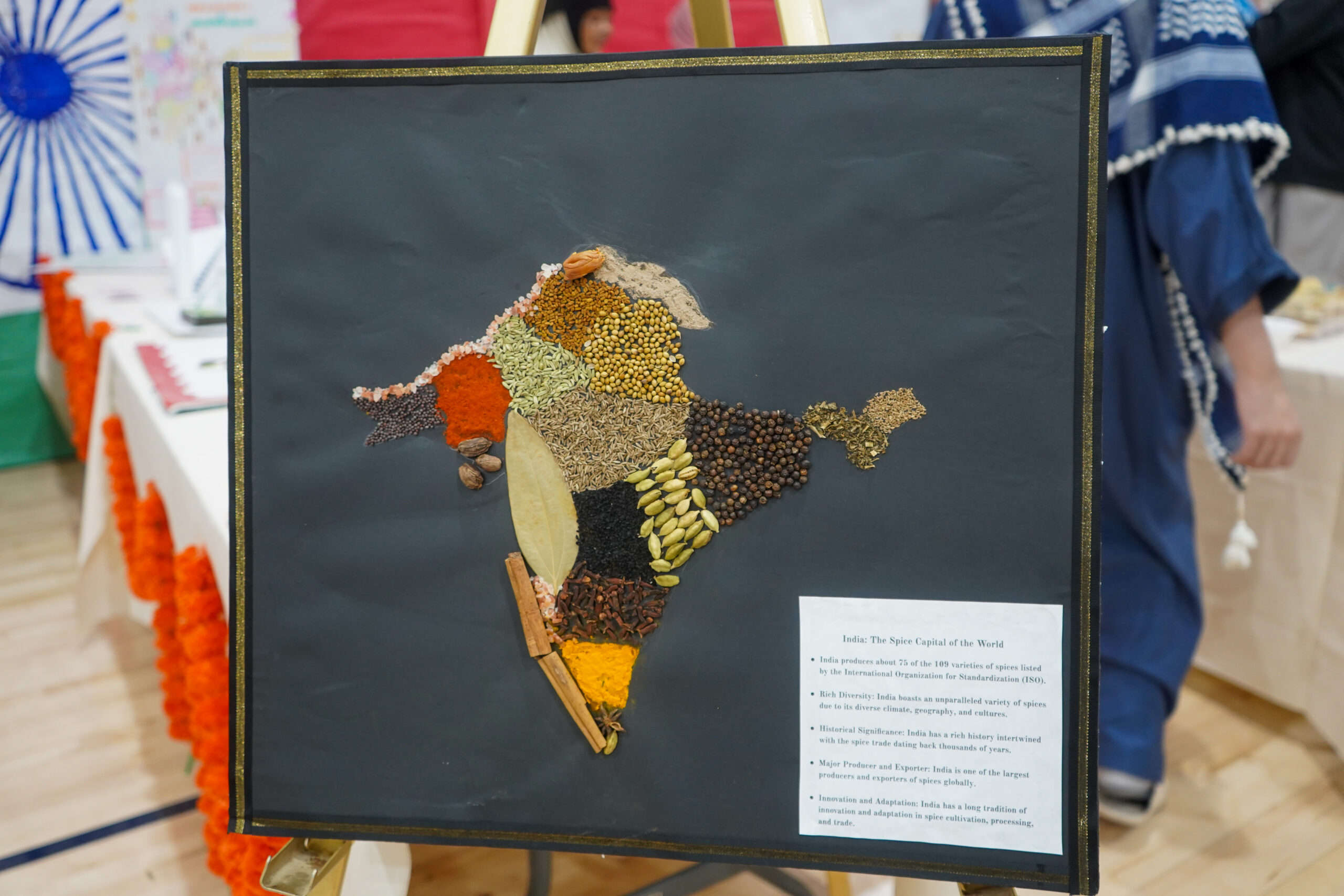
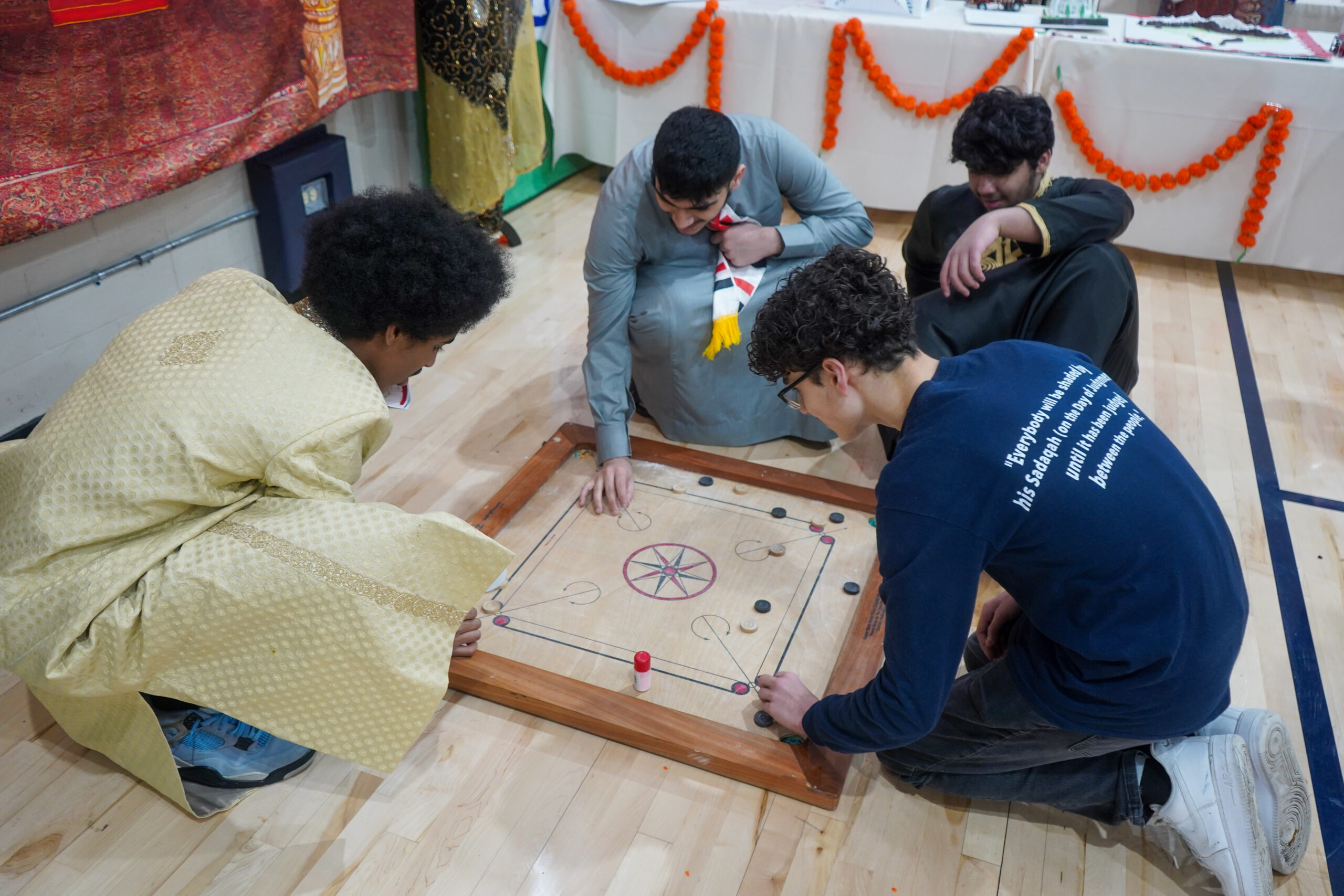
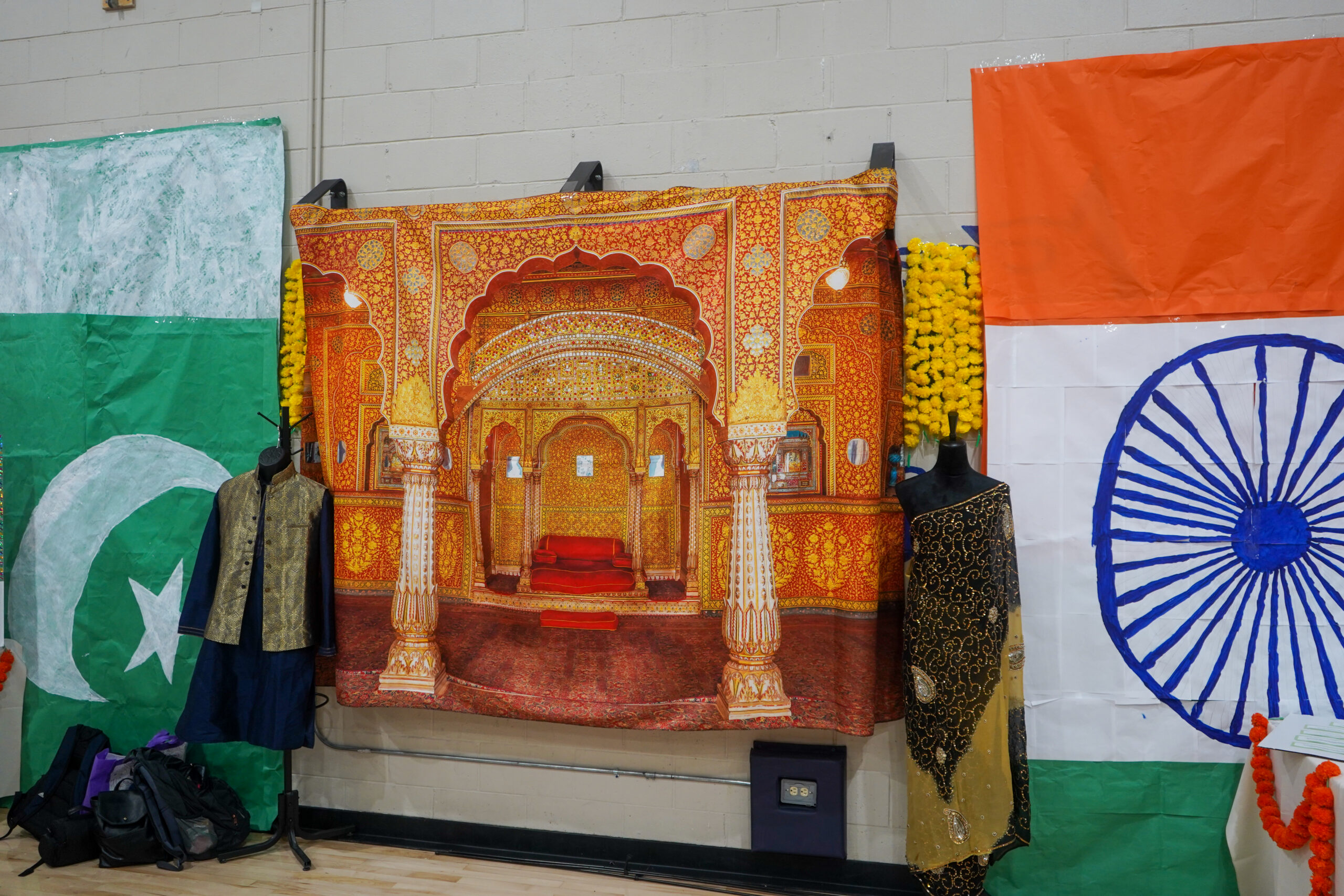
At the Tunesian booth, Sophomore Maysem Abubaker talked about an ancient Tunisian university’s famous library. “It burned down and they rebuilt it,” she explained. “They made a lot of contributions to Islamic jurisprudence.”
Before MLD day, what she knew about Tunisia came mostly from watching the World Cup, she said. “But with this project, you go in-depth—see the clothing, learn a lot of information and history, taste the food and it’s all stuff I never tried before. That’s what makes this day so special.”
Sophomores Khkola Halimey and Maryam Ali offered guests homemade couscous, a famous North African dish. Sisters senior Yassmine and freshman Narjis Hachani made it. They are Algerian Americans, Halimey said.
Junior Aseel Ishtaiwi said she was impressed with Moroccan architecture as she showed photographs of its universities and mosques.
“One of the oldest universities in the world, the University of al-Qarawiyyan in Morocco, was originally built as a masjid, then developed into a school,” added sophomore Raya Mahmoud.
Sophomores Moataz Manasrah and Ashir Imran researched Moroccan scholars and pointed out an actual ancient book provided for their display.
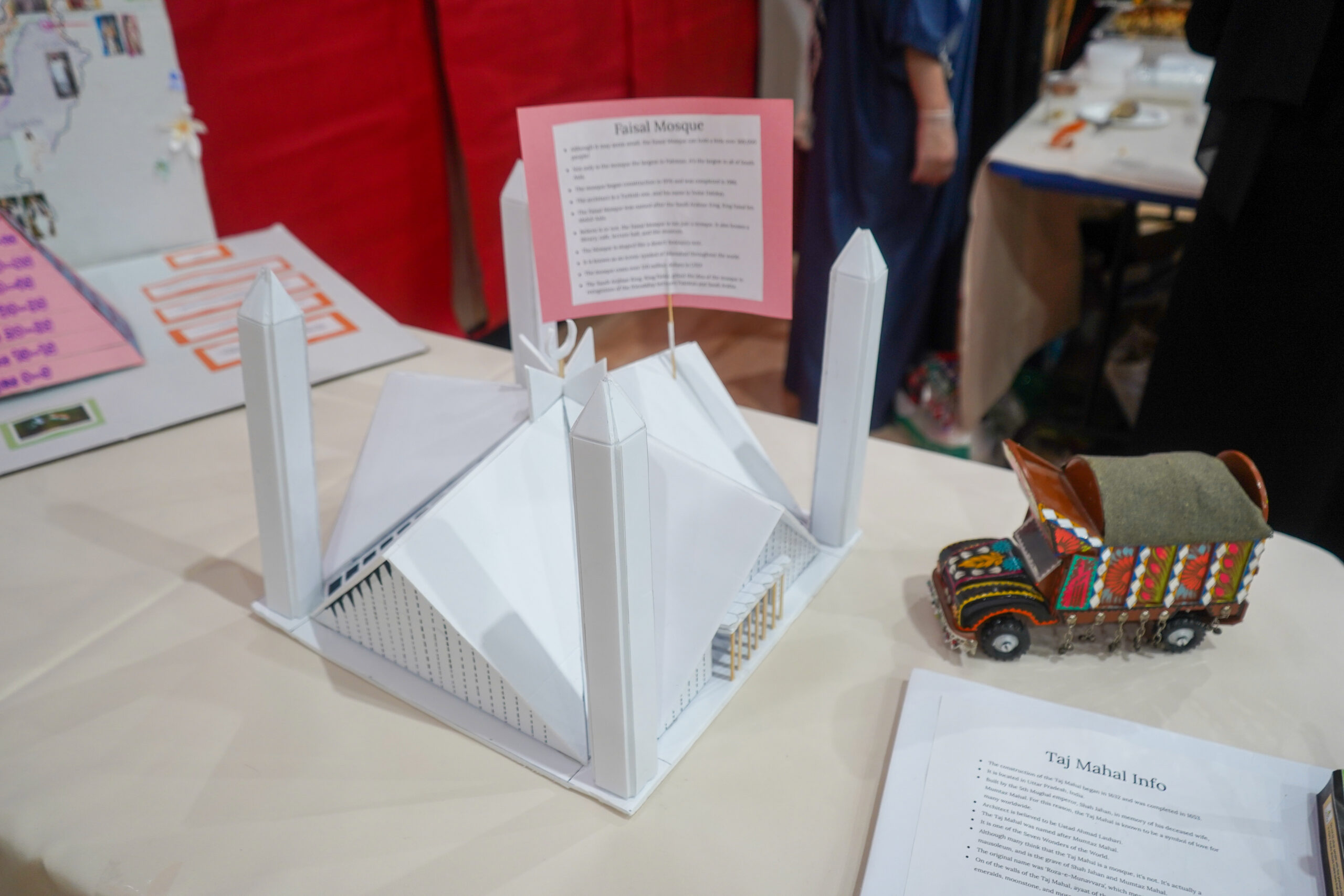
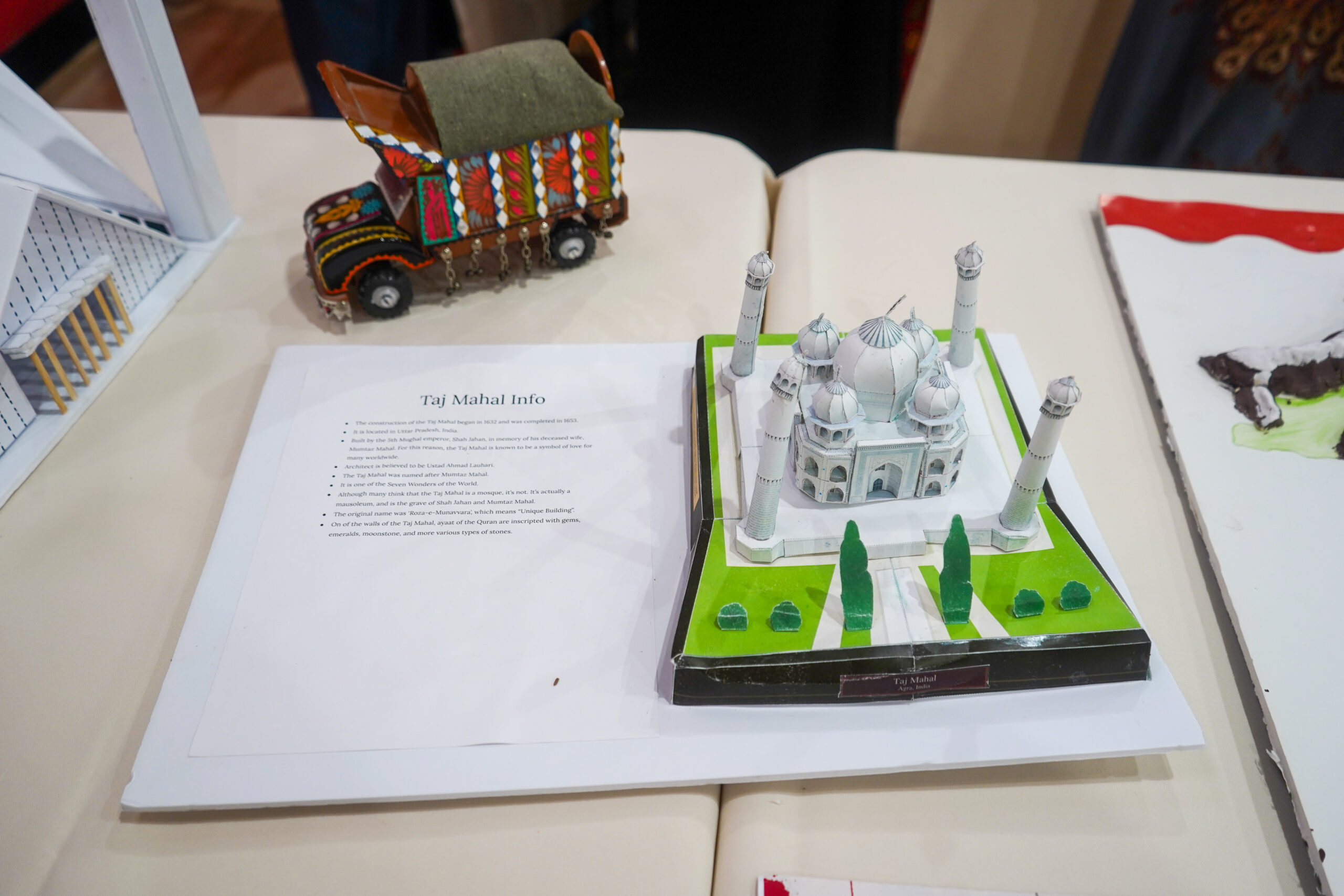
Senior Ahmed Subhi stood with other young men dressed in traditional clothes from India and Pakistan, offering tasty treats to people strolling past their exhibit. “The food is the biggest attraction,” he said. Behind the food table, half a dozen boys sat on the floor, playing Carob Qara Qara, a board game.
Learning the history of India and Pakistan was most interesting, Subhi said. “I’m quite young so I thought India and Pakistan had always been separate countries. It was actually one country and there was a lot of conflict when it split. And there’s still a lot of tension there nowadays. It’s fascinating to see how dynamic the cultures are.”
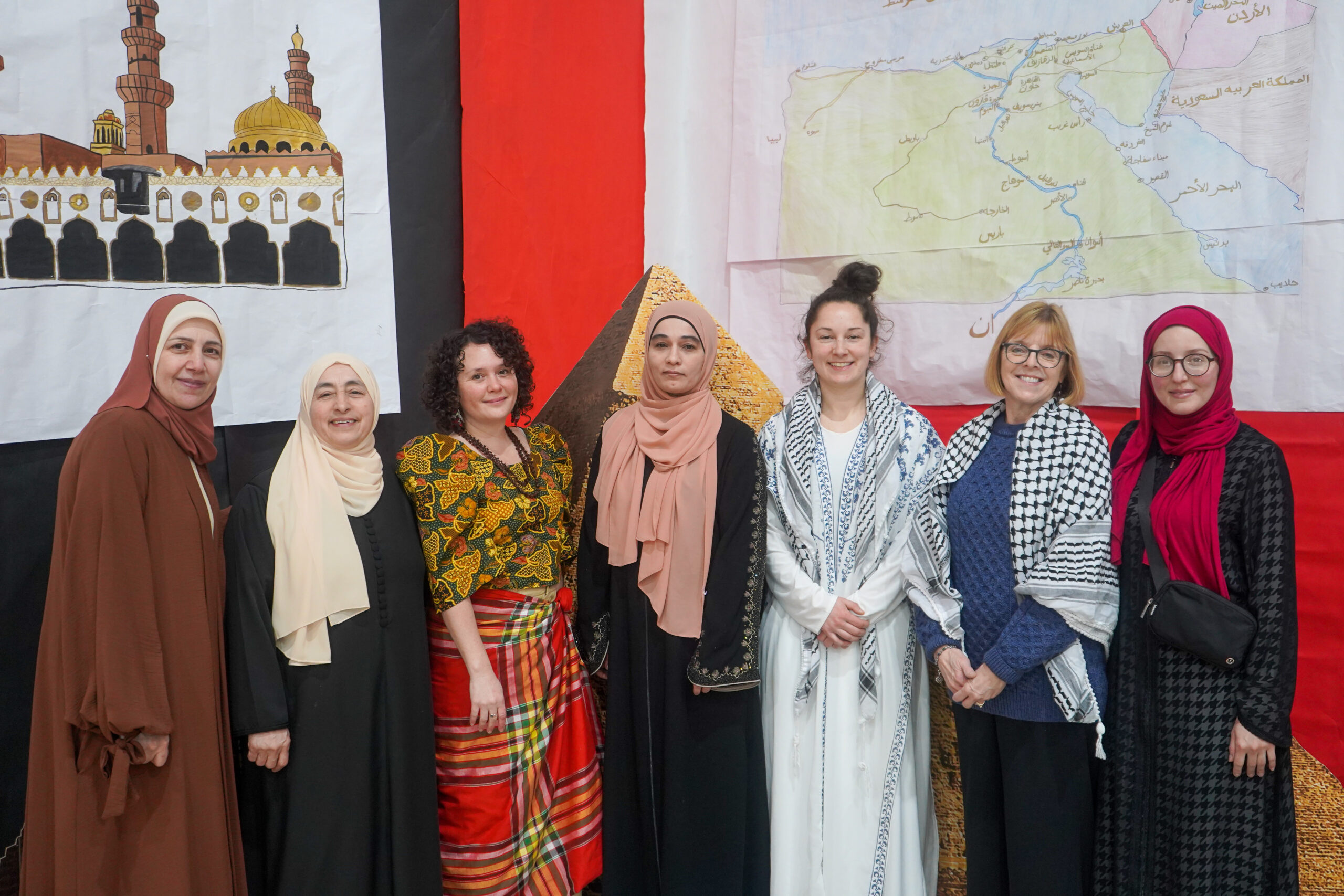
Salam School faculty members enjoyed Multilingual Day. (Left to right) Arabic teachers Majdoline Badwan and Sabah Hamdan, English teacher Anna Stone, Arabic and Quran teacher Mona Ziadeh, athletic director Kassidi Macak, social studies teacher Terese Wright and French and Arabic teacher Boushra Saad
In front of the Egyptian exhibit, freshman Danya Shibayih said she learned “some really cool things about Egypt” she didn’t know before. “I never knew falafels were from Egypt. Their food is really good. I never tasted something like this.
“And Cairo University is really amazing,” she said, pointing to a three-dimensional model. It was founded in 1908, a brochure her group created explained. The brochure also featured Al Azhar University, the most famous university in the Islamic world.
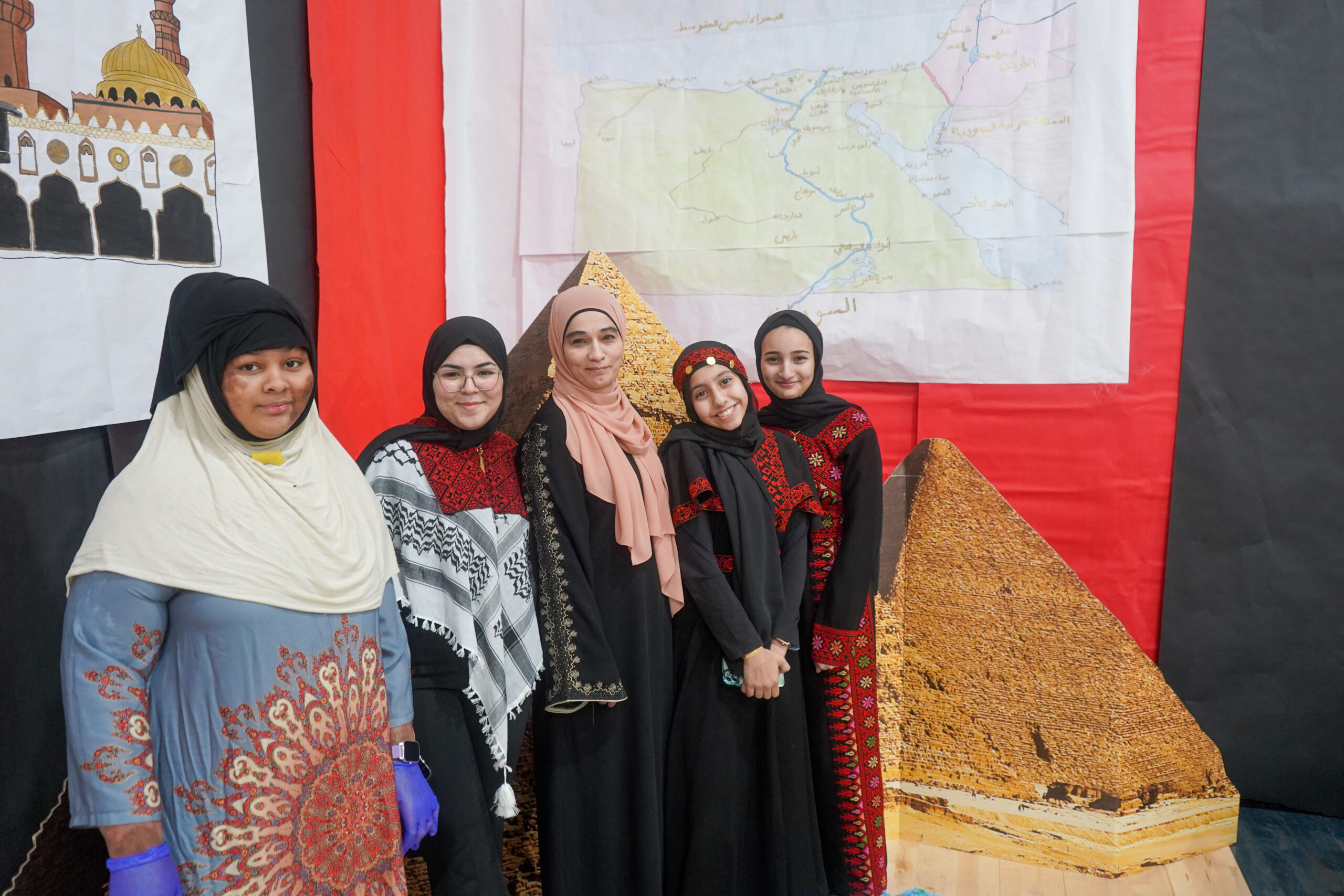
(Left to right) Asha Hassan, Basma Sarsour, Quran and Arabic teacher Mona Ziadeh, Danya Shilbayih and Jwana Alatari
She pointed to a three-dimensional map of the Nile River. “The 10th and 11th graders worked really hard on this,” she said.
Seventh grader Yazan Manasrah helped with the Egyptian food, creating a poster about it and bringing some in. Although his family is Palestinian, his mother made some of the food, cooking Egyptian style, he said. “I learned about the geography of Egypt and the food.”
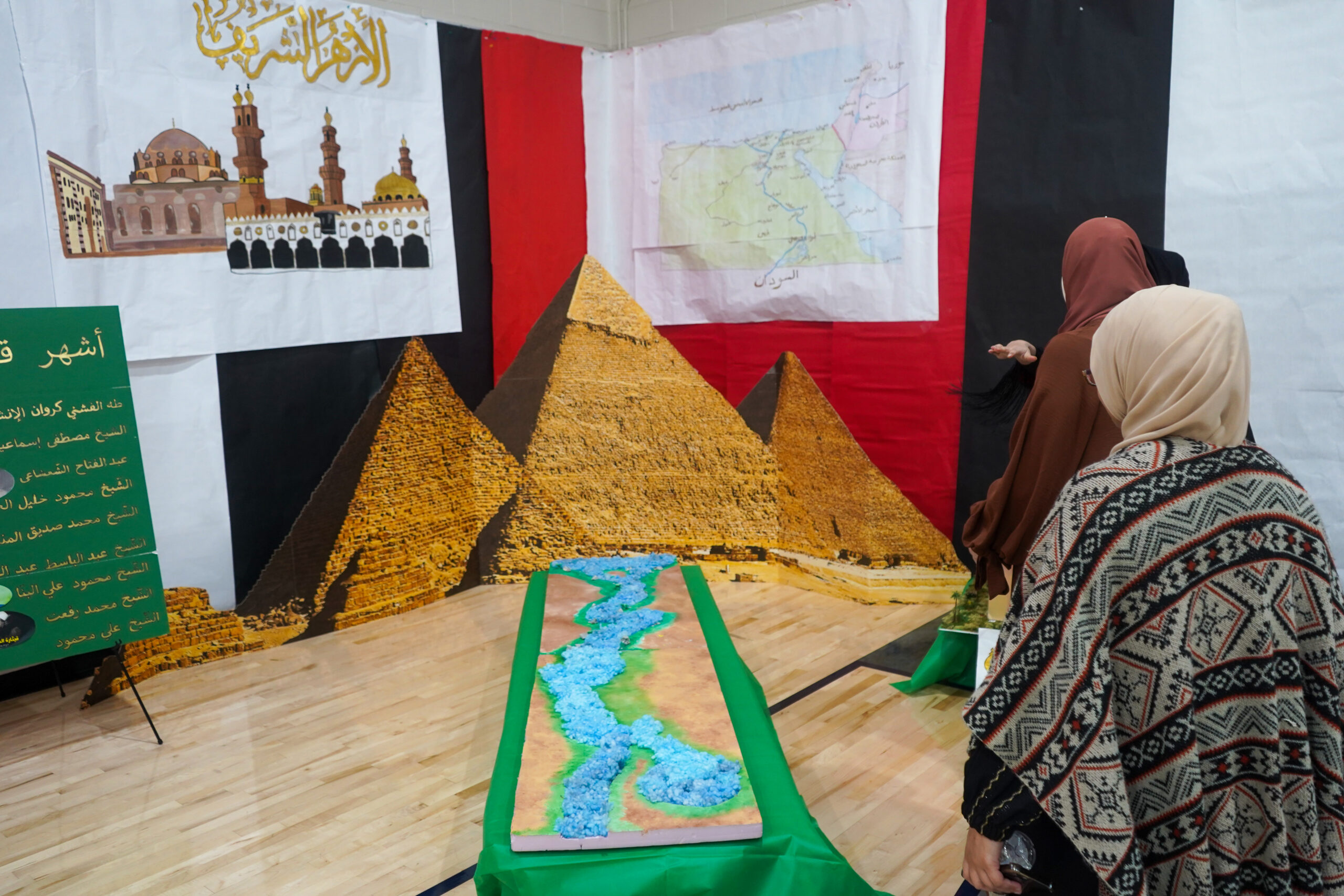
(Left to right) Anuar Habi, mathematics teacher Karen Roberts and Zu Bai admire the Egyptian exhibit.
Teachers were “wowed” by students’ work
“It’s an amazing event,” said Boushra Saad, who teaches middle school Arabic and high school French. “It brings everyone together and we all learn about different cultures. It’s really nice to learn about all the different cultures our students are from.”
High school Arabic and Quran teacher Mona Ziadeh was attending her second MLD. She has been at Salam School for three years but MLD was on hiatus through the COVID pandemic, she said. “Last year was the first year for me, and it was amazing. I loved it.
“Students learn so much from it,” she said. “They can talk about the universities, the scholars and Muslim culture from previous generations, about different countries and cultures.”
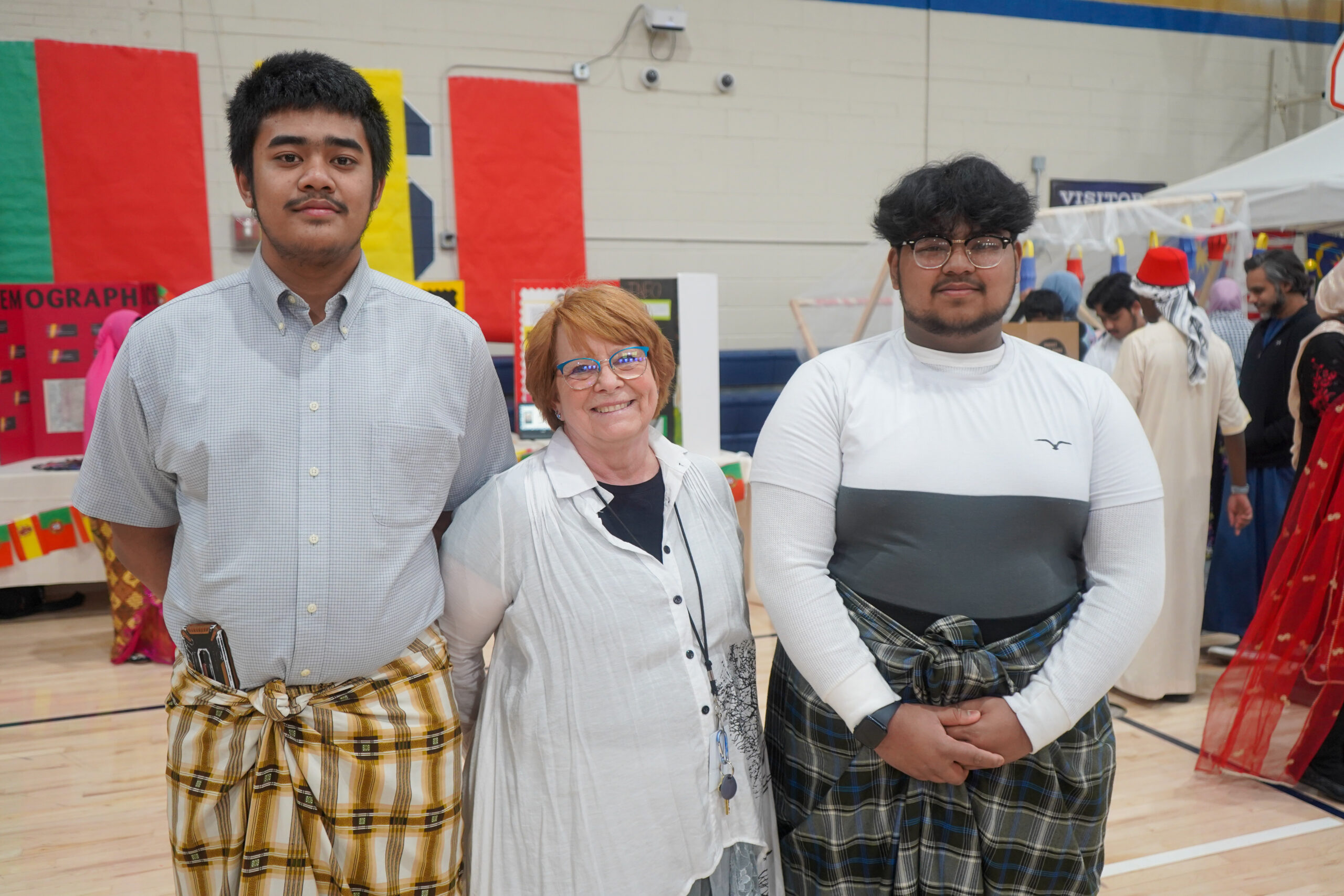
Enjoying Multilingual Day were (left to right) Anuar Habi, mathematics teacher Karen Roberts and Zu Bai.
Majdoline also teaches Arabic and Quran. She has been at Salam School for 14 years. Since it has become Multilingual Day, “students learn about so many different cultures and countries, the different languages and foods.
Freshman and sophomore English teacher Max Thiede was attending his first MLD. “I think it’s really, really impressive to see all the work the students have done. The Indonesian group spent a lot of time making food trucks and creating a street market. The students working on Egypt build replicas of the Nile River and their pyramids. Wow! It was really cool to see how excited students are to share about their own cultures and learn about others.”
AP psychology and sociology teacher Terese Wright was also attending her first MLD. “It’s really phenomenal the amount of effort and work that the students put in with the teachers. I can’t claim any of that because I’m part-time and wasn’t here when they worked on it. But I’m really enjoying seeing the great results.
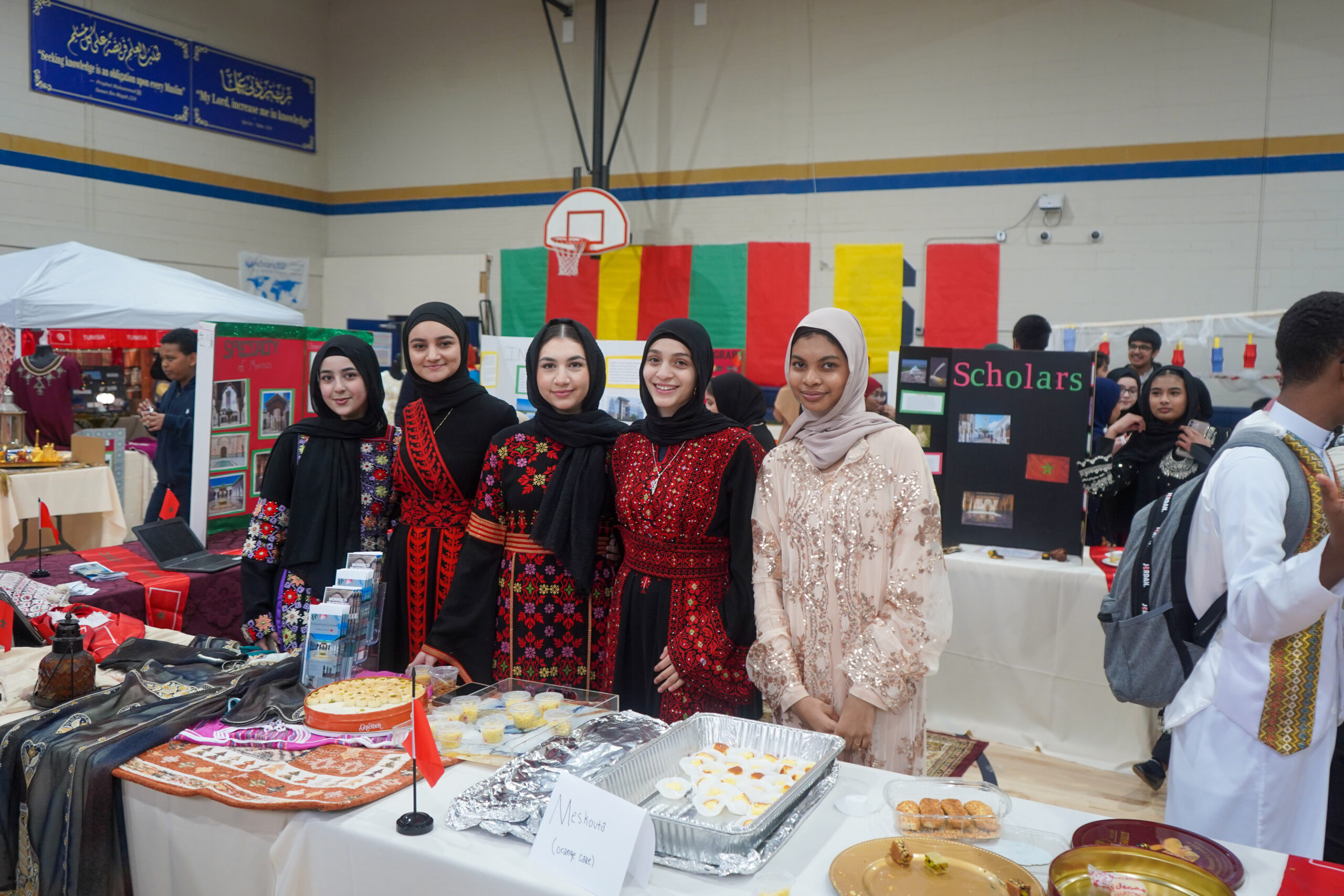
(Left to right) Reham Kaid (12th), Toleen Atari (12th), Jineen Atta (12th), Deena Alfoqaha (9th) and Nada Ahmed (9th)
A day to remember
Junior Zeena Saleh thought the whole experience was impactful, she said. “I was part of the Indonesia group and I thought it was really fun. I got to experience a culture that wasn’t mine. I also got to know other kids and learned about how we could work together. I actually made a few new friends.”
For Wisconsin Muslim Journal photographer Kamal Shkoukani, Salam School Class of 2006, the assignment to photograph MLD was a walk down memory lane.
“I did a booth for Puerto Rico,” he recalled. His mother is Puerto Rican and his father Palestinian. “My mom made a big pot of Puerto Rican beans and rice. We hit it off with the other students for sure. I remember a lot of great food.
“It was a much smaller school back then. It’s crazy to see how much it has grown.”

Morocco exhibit students, (left) Ashir Imran, (right) Moataz Manasrah
Today’s students are learning new things and making their own memories. When Bushra Darwish started researching Timbuktu, “I didn’t even know Timbuktu was a real place,” she said. “I always heard people mention it as a metaphor for a very far-away place.”
She learned Timbuktu’s University of Sankoré was a center of knowledge that played an important role in the development and teachings of Islam and other subjects like mathematics and physics.”
It reminded her of a lesson she has been learning all her life: “In Islam, we learn education is a valuable part of our faith.”
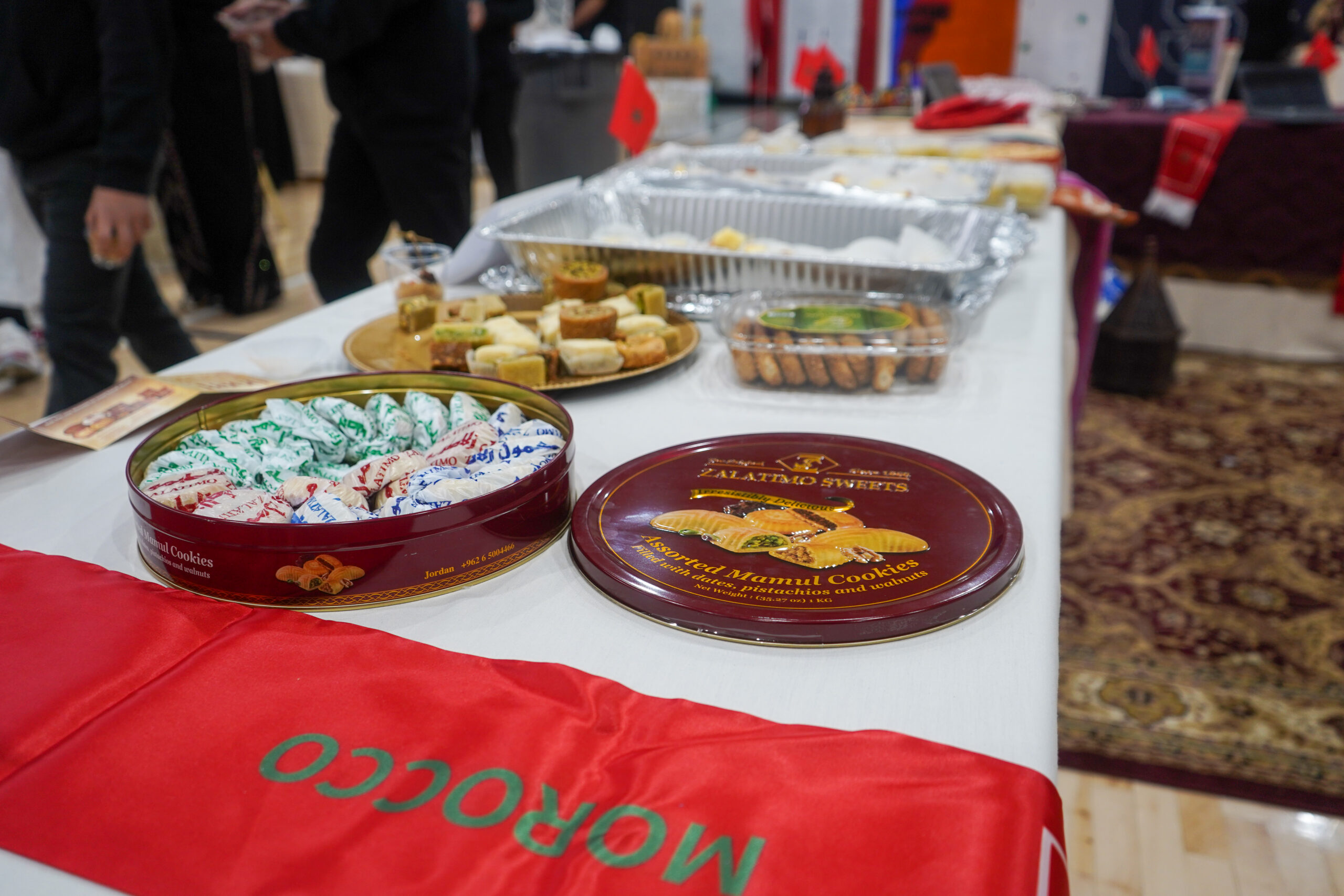
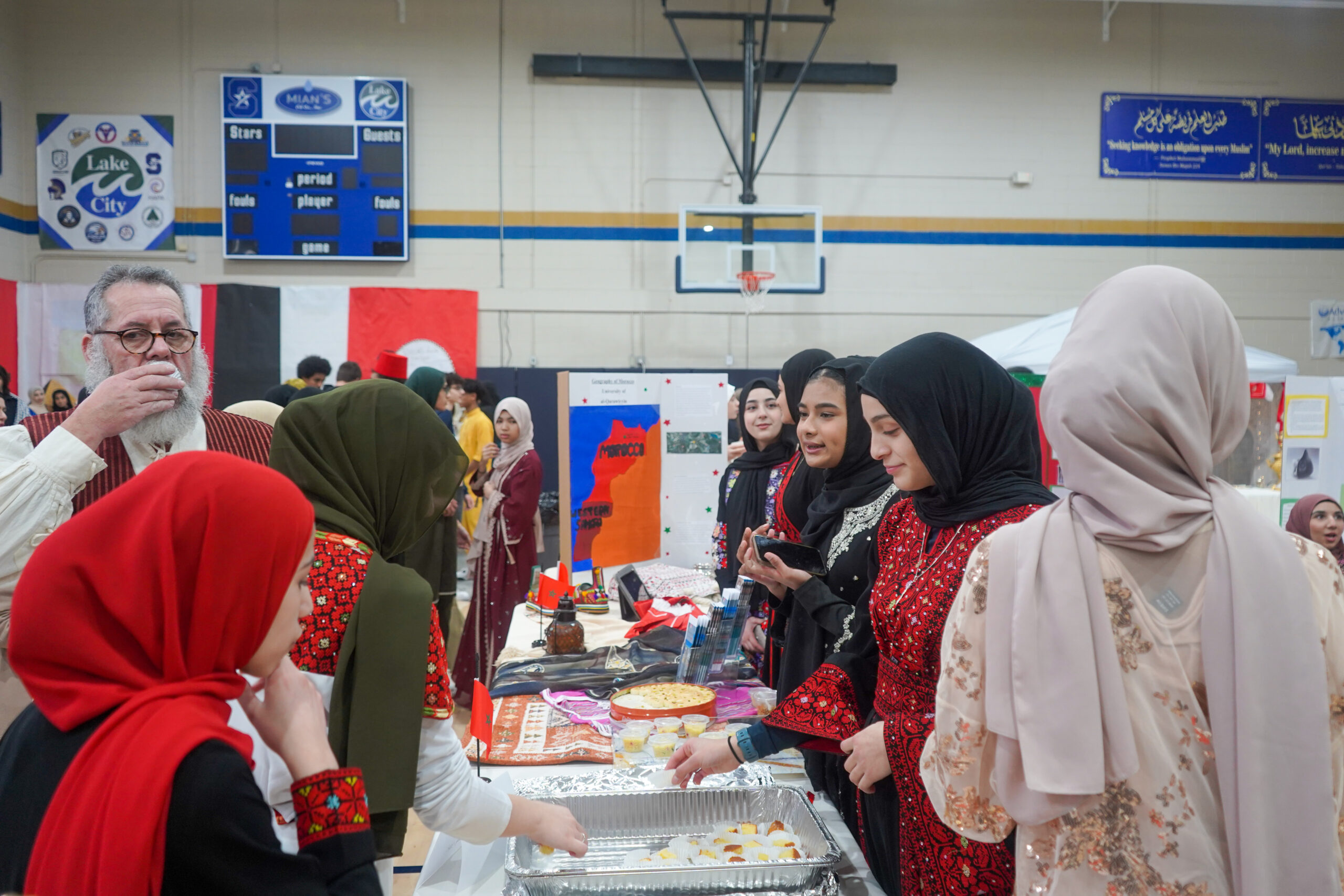
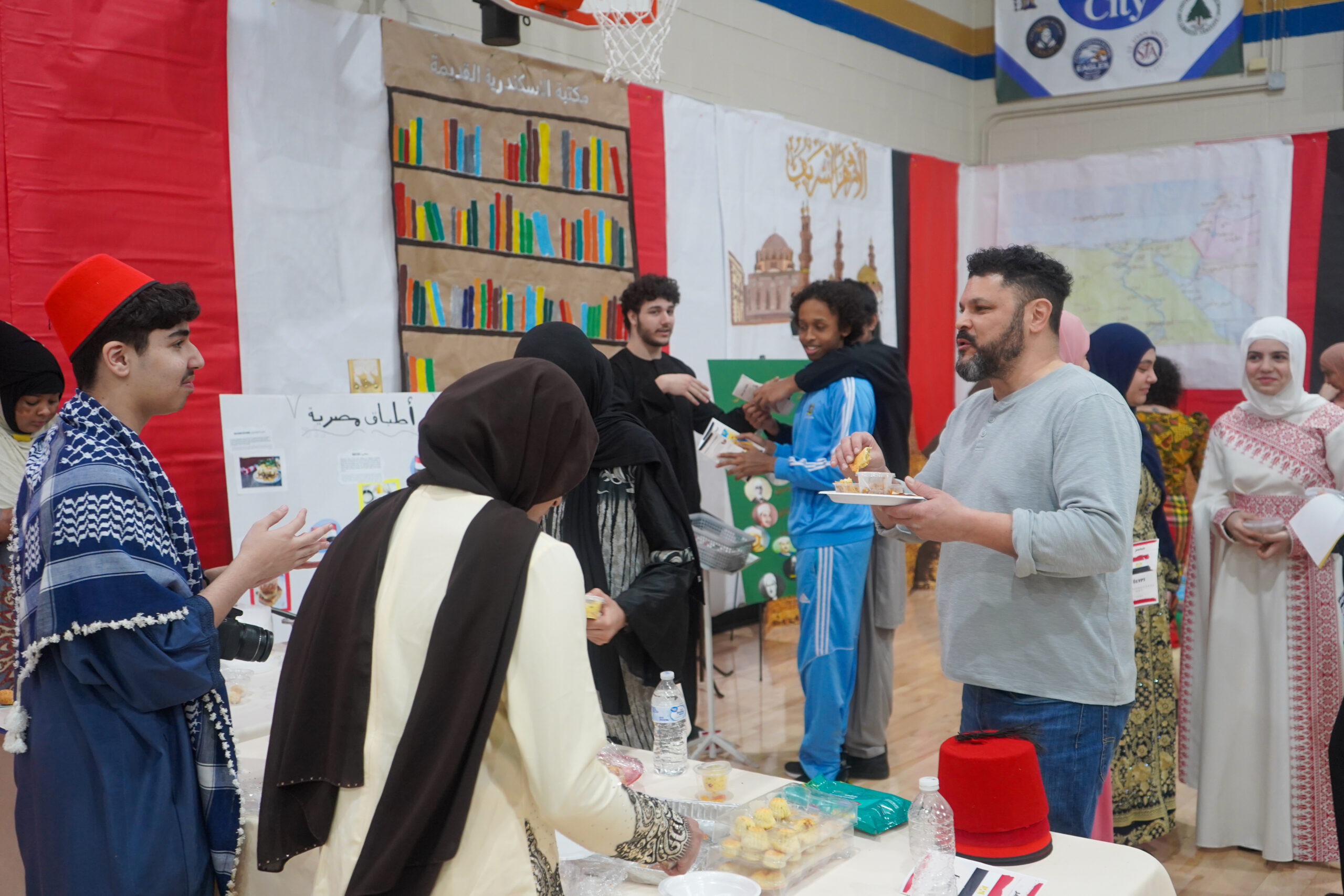
Editor’s note: Wisconsin Muslim Journal would like to thank Salam School mathematics teacher Ream Bahhur for her help with identifying students for photo captions.
